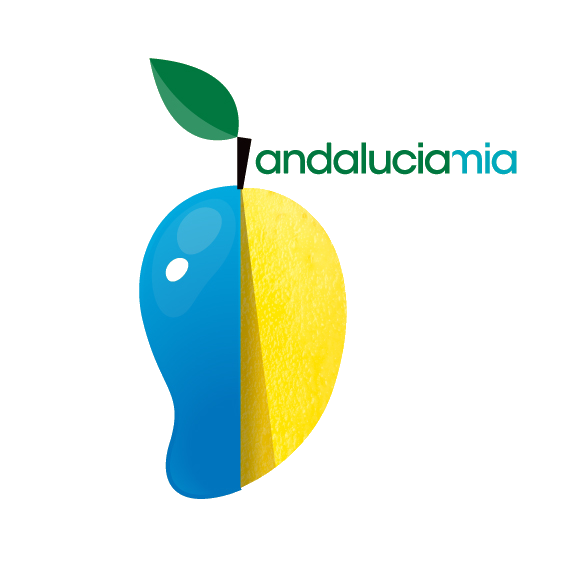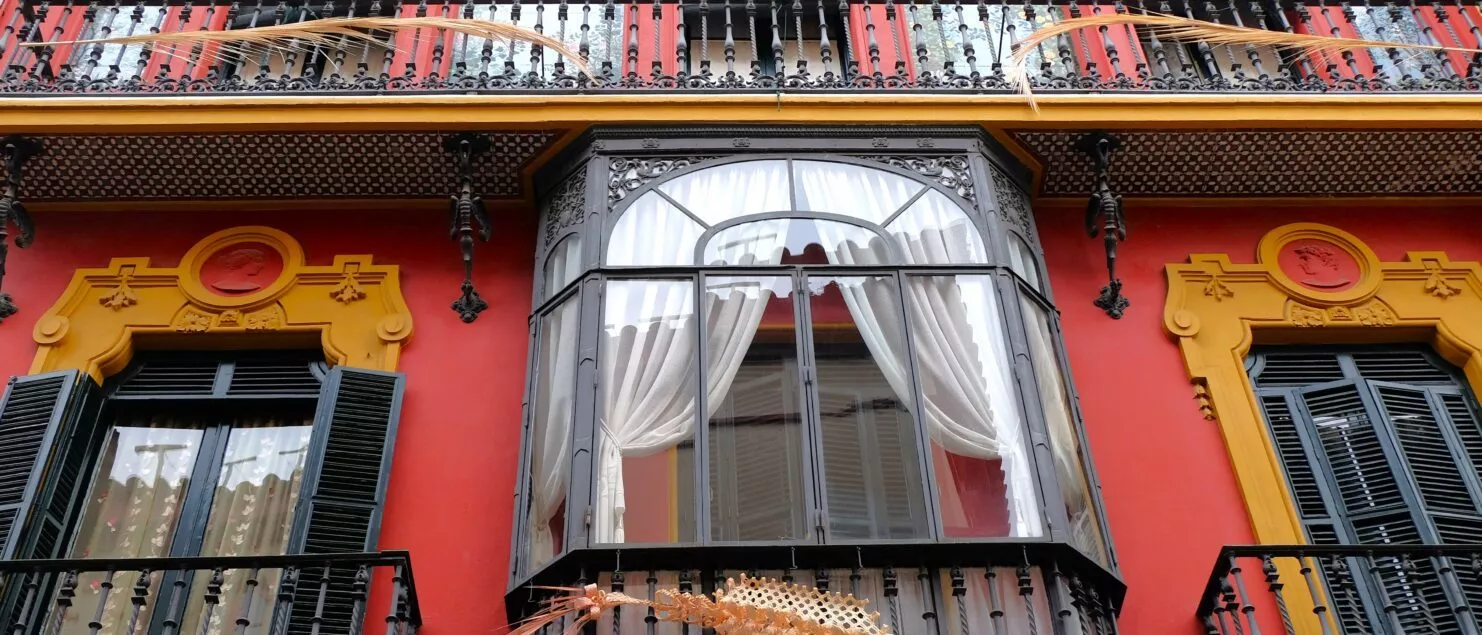Visit Seville in 3 days – the 18 must-sees and must-dos
Visit Seville in 3 days with the essentials to see and do
In this article, you’ll find all the information you need to visit Seville in 3 days or more:
- A few words about Seville
- A map of the centre of Seville
- Visiting Seville on foot
- What to see and do in Seville in 3 days
- Where to have a drink and some tapas?
- Things to do in Seville
- Some useful links for your trip
- Not-to-be-missed areas of Seville
- Continuing your trip to Andalucia
A few words about Seville history before visiting it
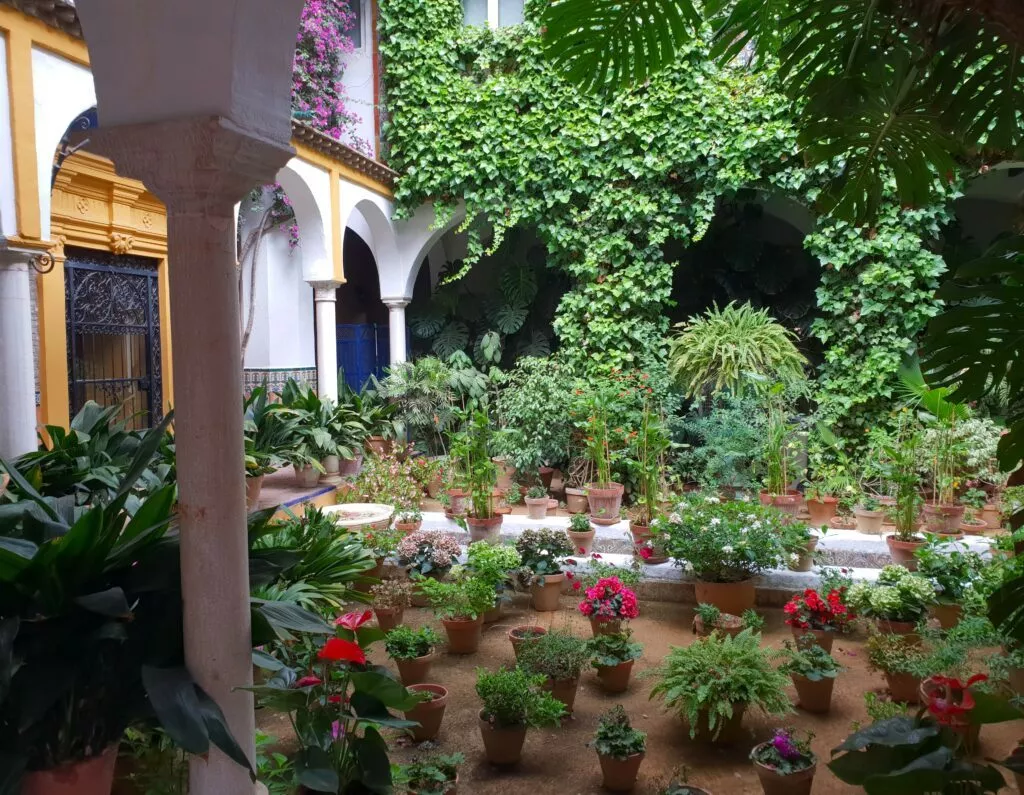
The two main historical periods for understanding Seville
Roman period
The origins of the city go back a thousand years. However, it was under the Roman Empire, just over 2,000 years ago, that Seville became a real city, Hispalis.
Following a decisive victory over Pompey, Julius Caesar gave the city the name Julia Romula Hispalis.
During the Roman era, Italica – well worth a visit – was founded first by Scipio the African and then, a little further on, Hispalis in 206 BC, which would become modern-day Seville.
The Al-Andalus period
Seville was taken from the Visigoths during the Muslim conquest in 712. It remained Muslim and was known as Ishbiliya until 1248, when it was conquered by the Catholic kings.
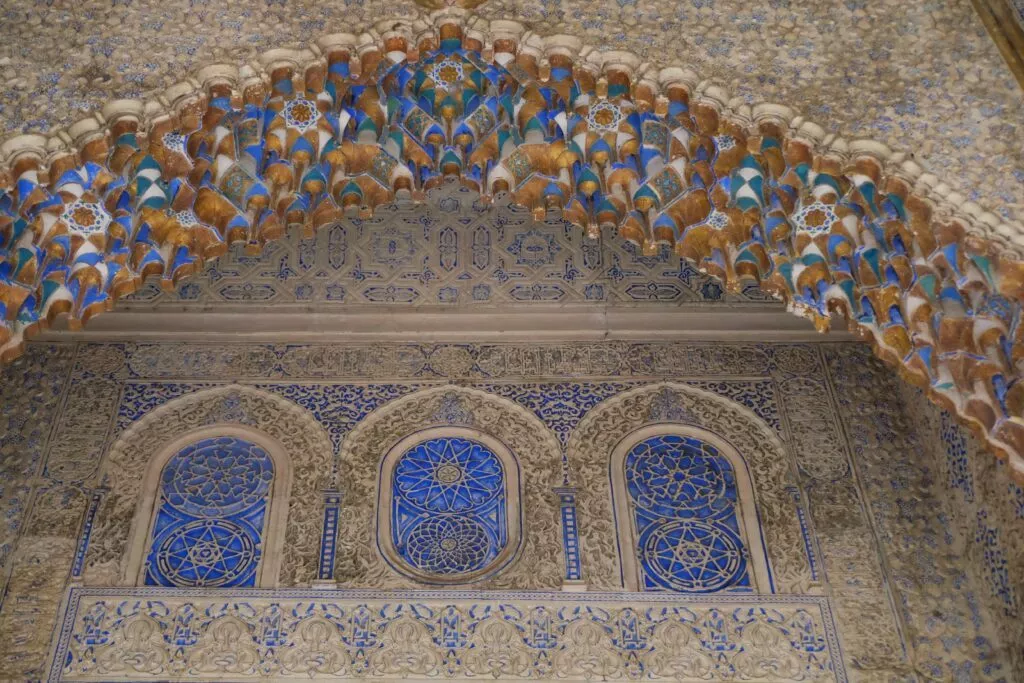
It is of course from this period that the legacy is the greatest (Alcazar, Torre del Oro, etc.) and the most beautiful, although of course the period of the discovery of the Americas by Christopher Columbus will also greatly modify Seville.
Seville is a city rich in history and culture, and its monuments reflect this incredible diversity. Seville’s historic centre, also known as the Casco Antiguo or Old Town, is renowned for its rich history, cultural heritage and lively atmosphere.
The centre has been a UNESCO World Heritage Site since 1987, as have a number of monuments. The district boasts a mix of architectural styles, including Moorish, Gothic, Renaissance and Baroque, all of which are well worth a visit.
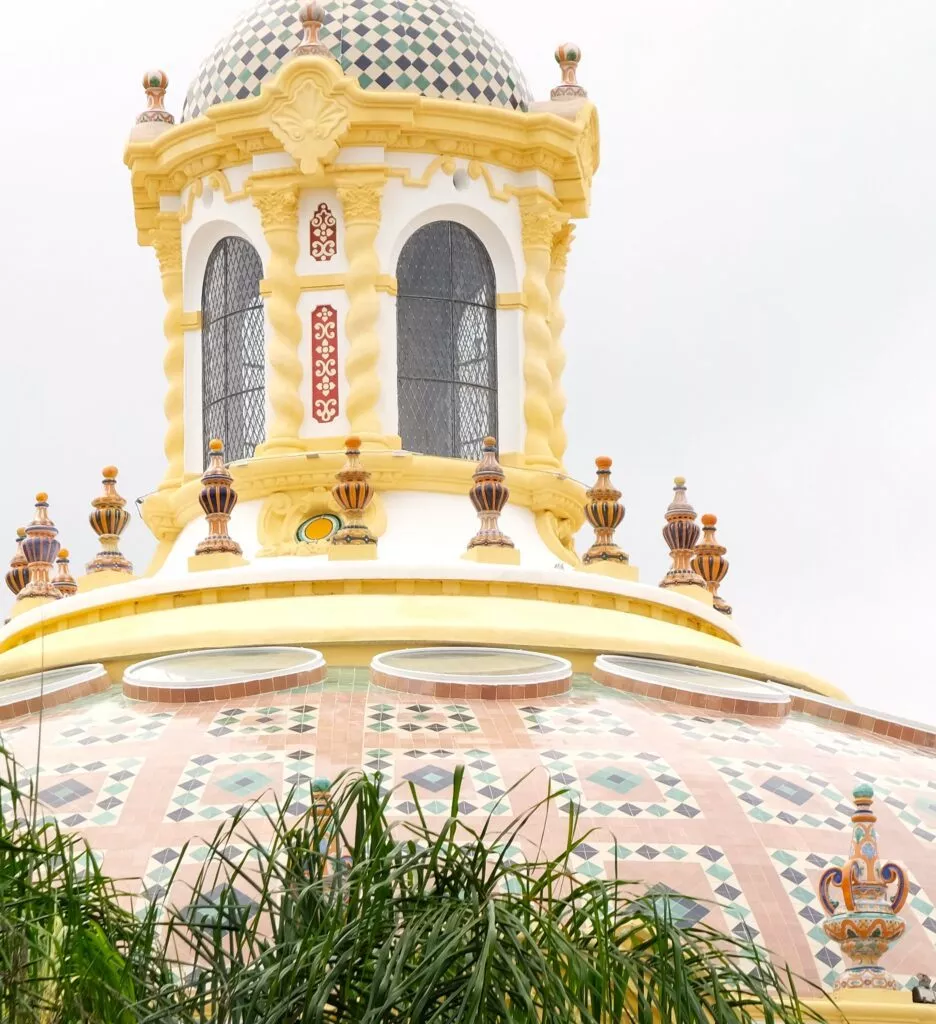
This page presenting the essentials of Seville’s historic centre is designed to help you make the most of your stay and retain unforgettable memories of this enchanting destination.
The centre of Seville on the map
On the map, the historic centre is outlined in red:
And here’s a map with the monuments to help you find your way around during your visit:
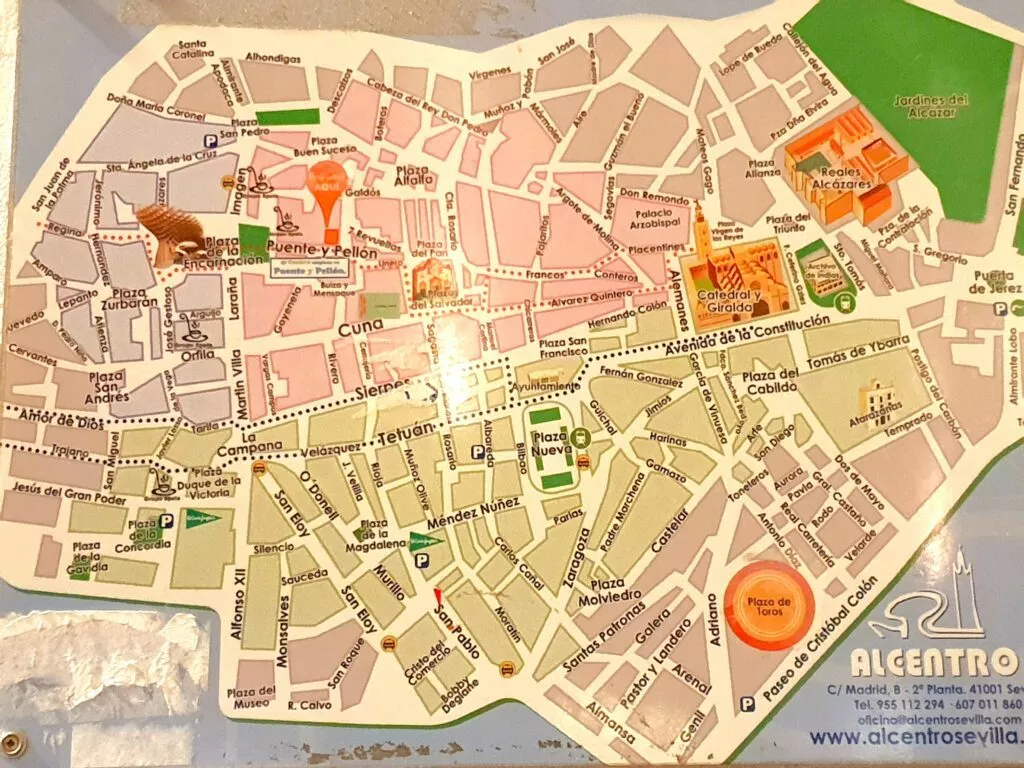
What to see and do in 3 days in Seville ?
- Cathedral
- Giralda
- Spain Square
- Postigo Abd-el-Aziz
- Metropol Parasol
- Torre de Oro
- Maria Luisa Park
- Pilate’s House
- Arenas
- the church of the Divine Savior
- the basilica of the Macarena
- Macarena Gate
- Alcazar of Seville
- the Alcazar gardens
- Palace of Las Dueñas
- Have a drink and some tapas
- Casa Morales
- Bar Alfala
- See flamenco
- Tablao Los Gallos
- Teatro Flamenco Triana
- Visit Seville at night
A last few words before visiting Seville
Seville is a city with an infinite wealth of history, culture and beauty. With its impressive architecture, picturesque streets and warm atmosphere, Seville is a destination of choice for travellers from all over the world.
In this article, we’ll take a look at Seville’s main sights and give you an idea of what you can discover when you visit.
Because, to be perfectly honest, you can’t visit Seville on foot in just 3 days to take it all in.
As you will see, Seville’s historic centre alone justifies spending 3 days in Seville, not to mention the treasures to be seen in the surrounding districts such as Triana and Santa Cruz. The best thing for everyone is to choose according to their historical, cultural or architectural affinities.
The Cathedral a wonder to visit in Seville
Seville Cathedral is a Catholic religious building. It is one of the largest religious buildings in the world. As such, it is considered to be the largest Gothic temple in the world.
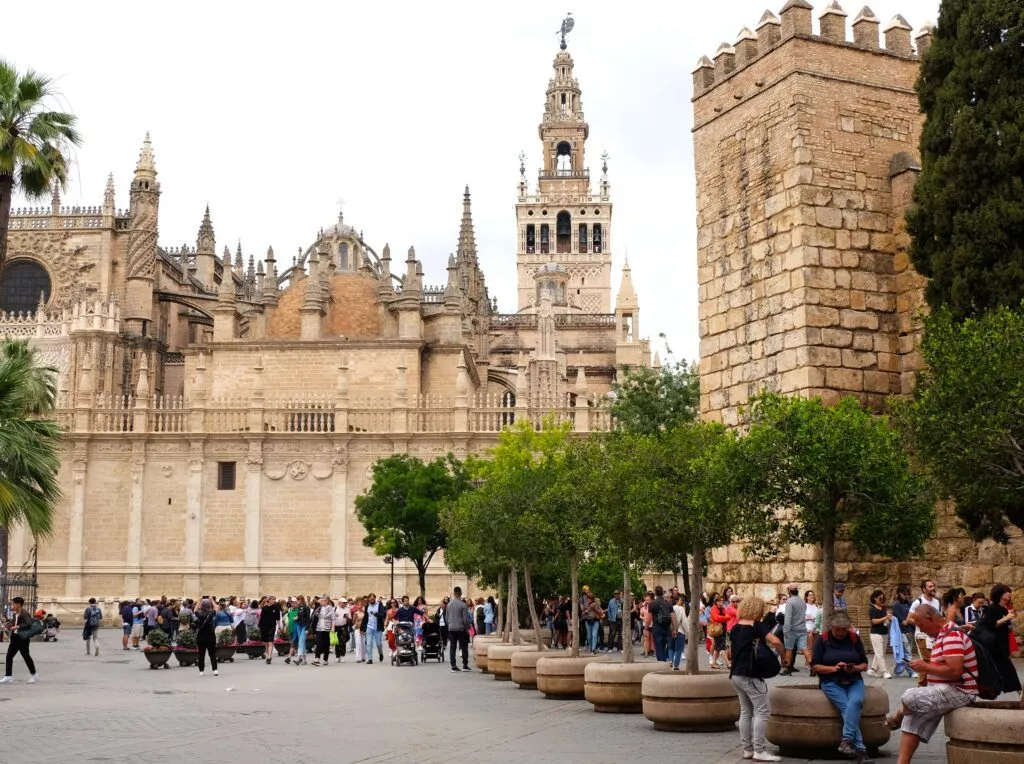
Seville Cathedral – Catedral de Santa María de la Sede – is a UNESCO World Heritage Site and one of Spain’s most popular tourist attractions. It is a must-see for visitors to Seville.
The cathedral was built on the site of a former Almohad mosque, which was destroyed after the Reconquista. Construction of the cathedral began in 1402 and was completed in 1520.
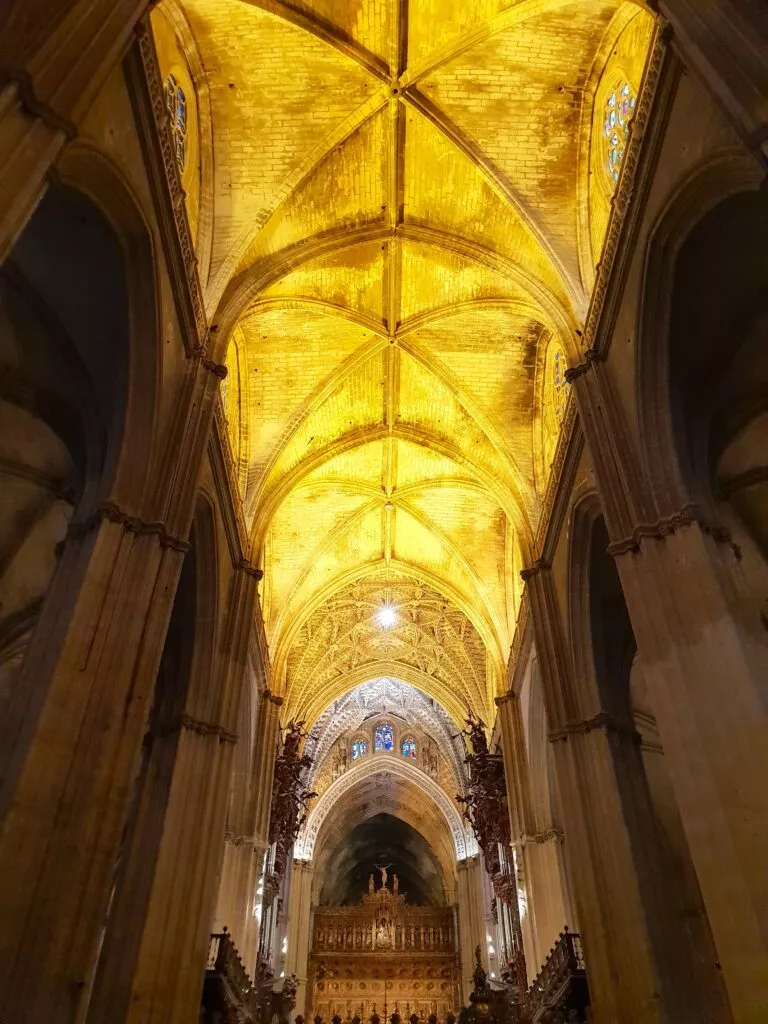
Highlights of a visit to the cathedral include :
- the 16th-century Gothic choir.
- the Royal Chapel
- the tombs of three former kings
- works by Zurbaran and Murillo, among 550 paintings…
- a work by Goya too, depicting Justa and Rufina
- the tomb of Christopher Columbus
- around 30 side chapels
- the Patio de los Naranjos, a direct legacy of its time as a mosque. The courtyard of orange trees, corresponding to the ablutions courtyard of the time.
- 10 entrance doors to the cathedral
- a hanging wooden crocodile (your guide will tell you all about it…)
- the altarpiece… the largest in the Christian world… with a surface area of 400 square metres
- the famous Puerta del Perdón. This is the oldest of them all and the only one left of the old Almohad mosque. It was the mosque’s main door.
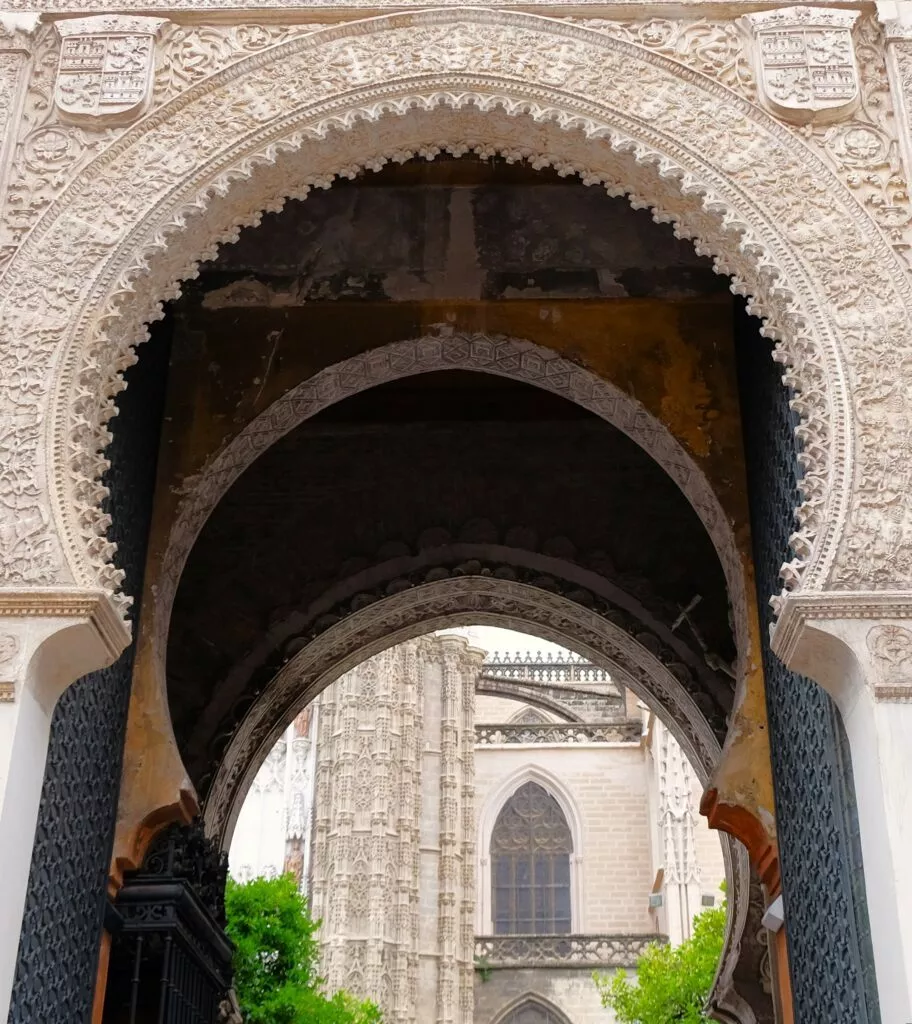
The Gate of Forgiveness – Puerta del Perdón –
From the mosque that occupied the site before the Cathedral, there remains this magnificent Gate of Forgiveness and the Giralda, the old minaret and the patio de los naranjos. This fine 12th-century legacy was left to the Almohad Berber caliph Abu Yuqub Yusuf after his victory over the Almoravids in 1147.
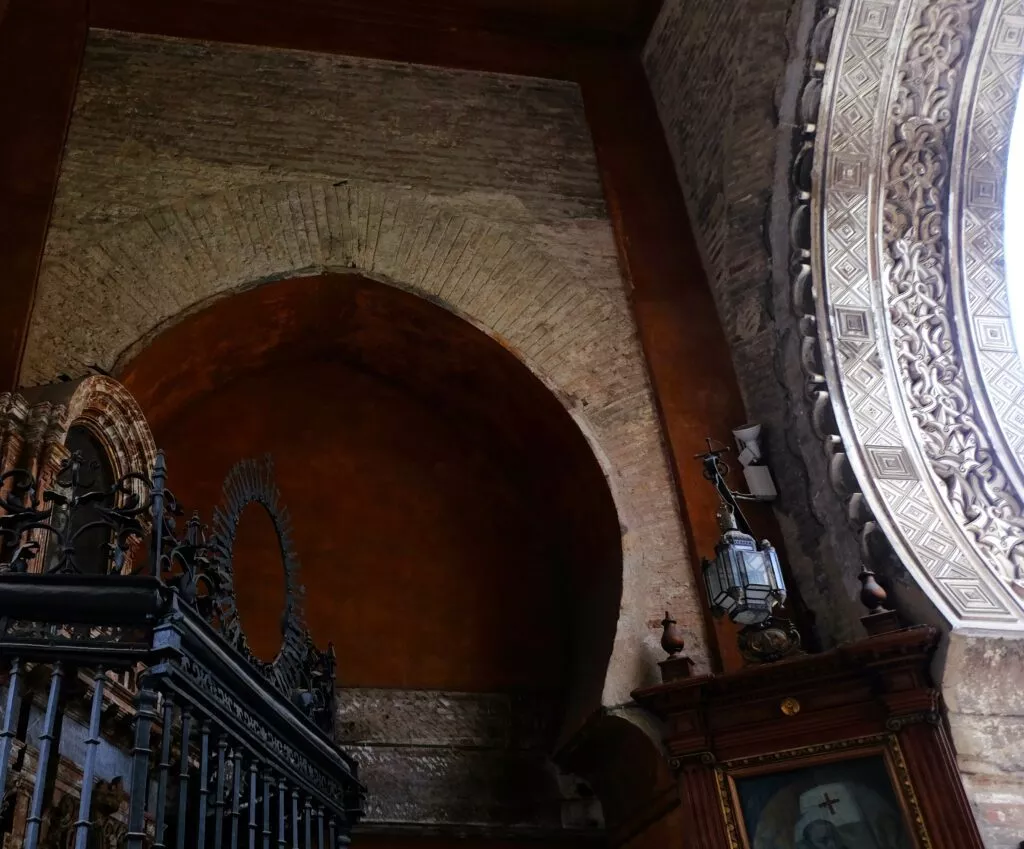
Note: to get a fairly accurate picture of the mosque in the 12th century, take a look at photos of the mosque at Tinmel, in the Moroccan Atlas mountains. It was built, also by the Almohads, 25 years before the one in Seville.
This was the period of Seville’s greatest splendour and the one that shaped Seville as we know it today. It was during this period that the great city walls were built, along with the Torre del Oro, Triana Castle and the first bridge. A floating bridge – El Puente de las Barcas -.
To finish the presentation on the cathedral, and as if to confirm the importance of visiting it: After being declared a World Heritage Site in 1987, UNESCO also declared Seville Cathedral to be of Outstanding Universal Value in 2010!
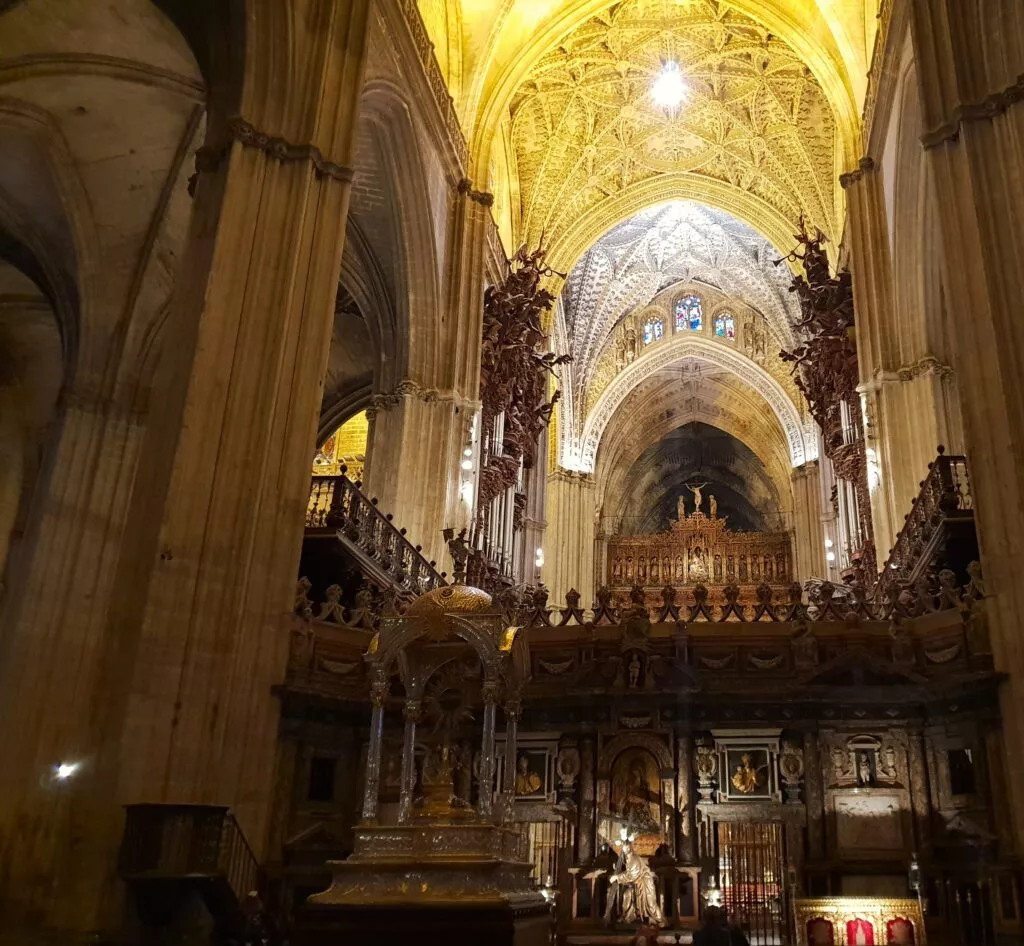
To book a ticket online to visit the cathedral and the Giralda.
The Giralda
The Giralda is the bell tower of Seville Cathedral. As we have seen, it is an ancient Almohad minaret that was converted into a bell tower after the Spanish Reconquista.
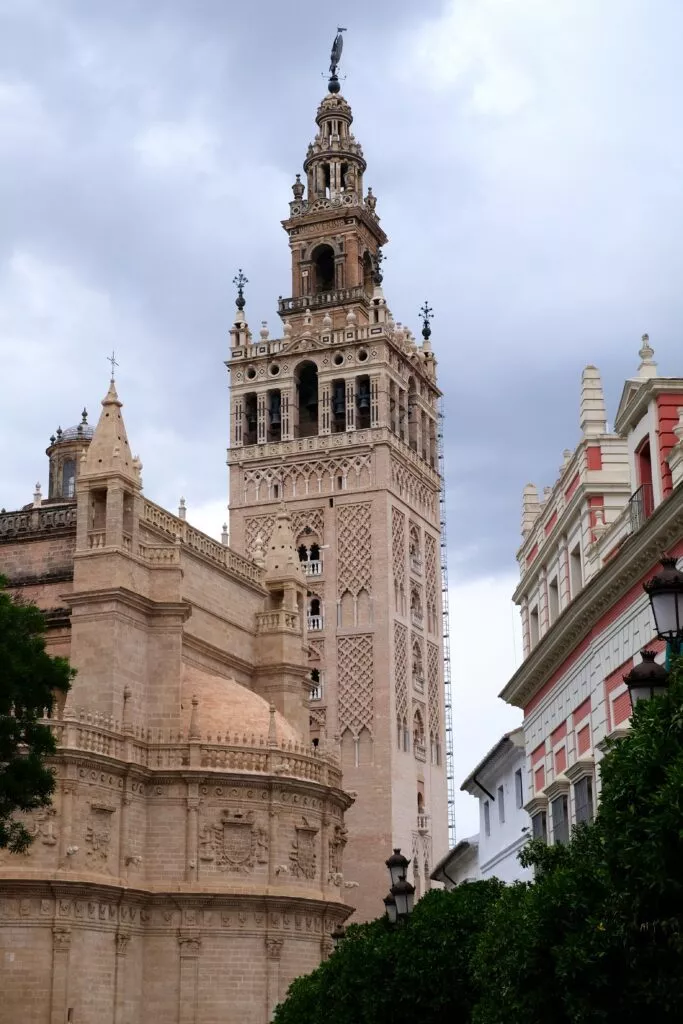
The Giralda is an emblematic monument of Seville and a symbol of the city’s history and culture. It is a must-see in Seville.
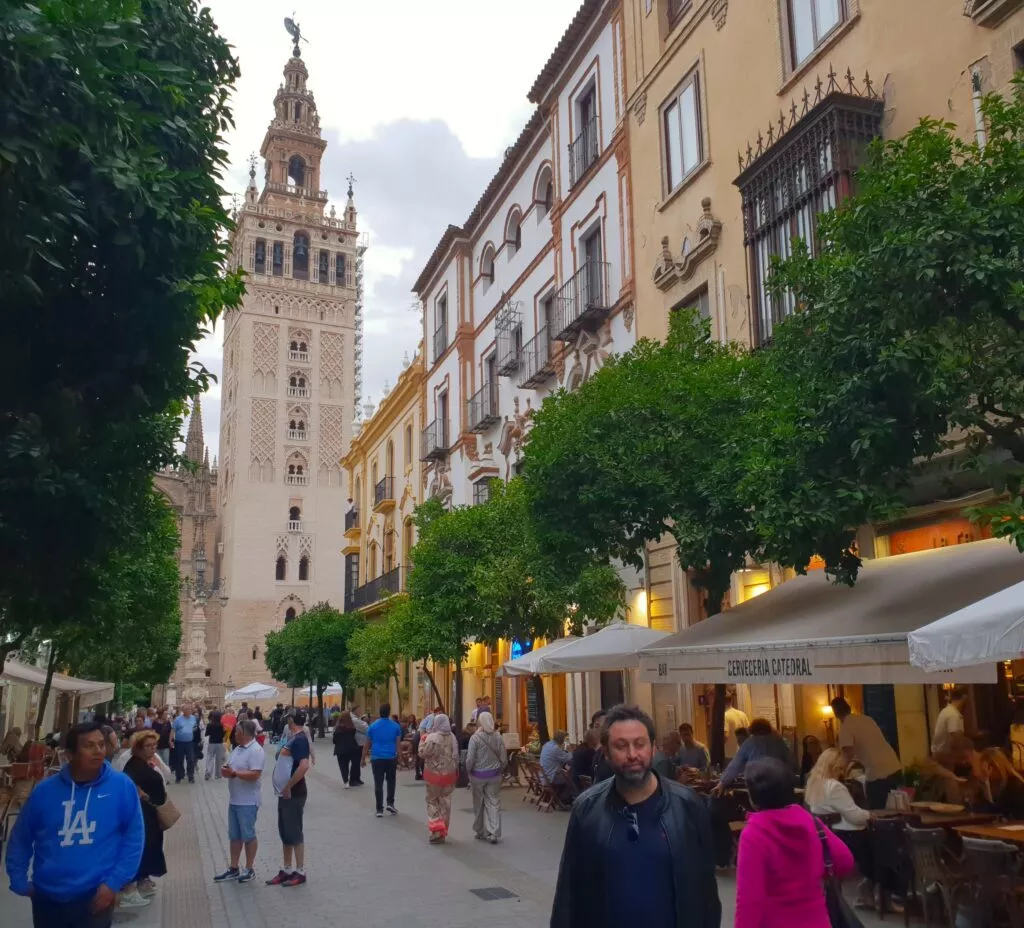
Here are some basic facts about the Giralda before you visit:
- it is around 100 metres high, the tallest cathedral tower in Spain
- It is also one of the tallest minarets in the world.
- built between 1184 and 1198
- built with stones from ancient Roman, Visigoth and Abbasid buildings
- designed by Almohad master mason Ahmad al-Ghafiqi.
- decorated with Moorish and sebka motifs, including wrought-iron arches, friezes and mosaics.
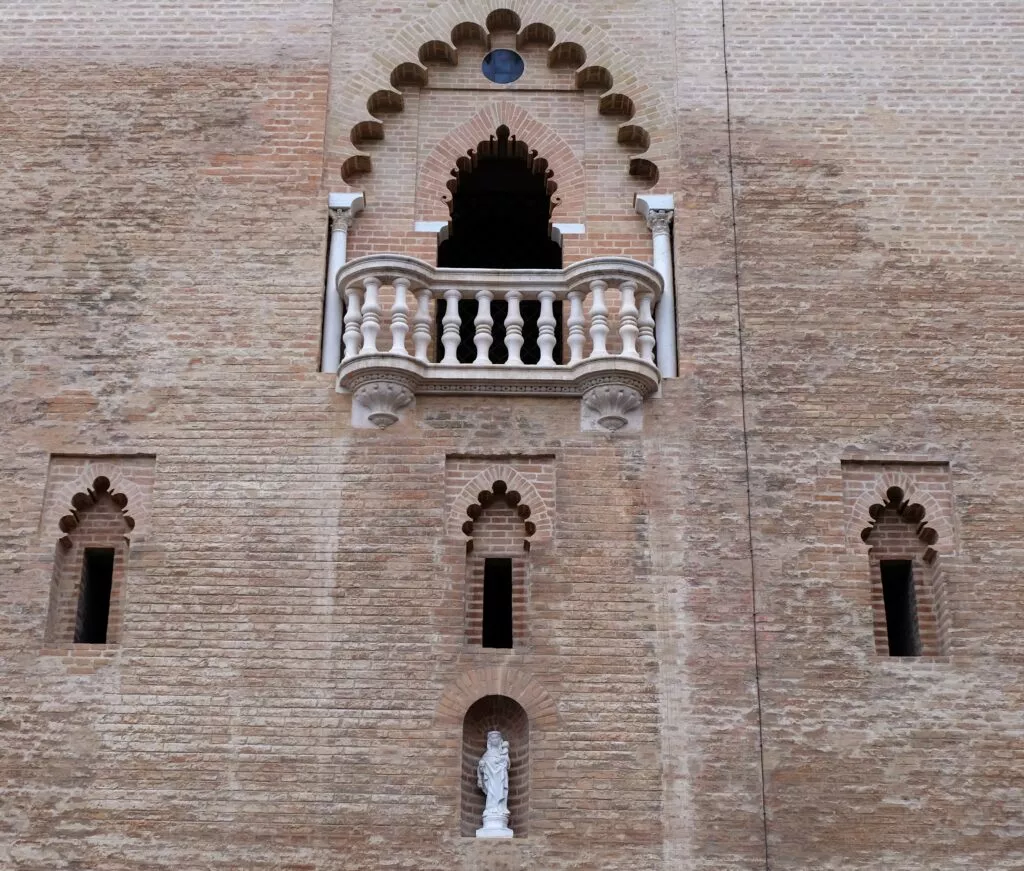
- The last third of the tower, in Renaissance style, was built in the 16th century and is topped by a bronze statue representing the Triumph of Faith, which acts as a weathervane.
- remember to buy your tickets in advance during the high season.
- wear comfortable shoes… as you would for any walking tour of Seville.
- enjoy the breathtaking views of the city from the top of the Giralda
The Giralda’s ‘minaret part’ is inspired by two minarets in Morocco built by the Almohads – a tribe of Moroccan Berbers. These are the minaret of the Koutoubia mosque in Marrakech and the Hassan Tower in Rabat.
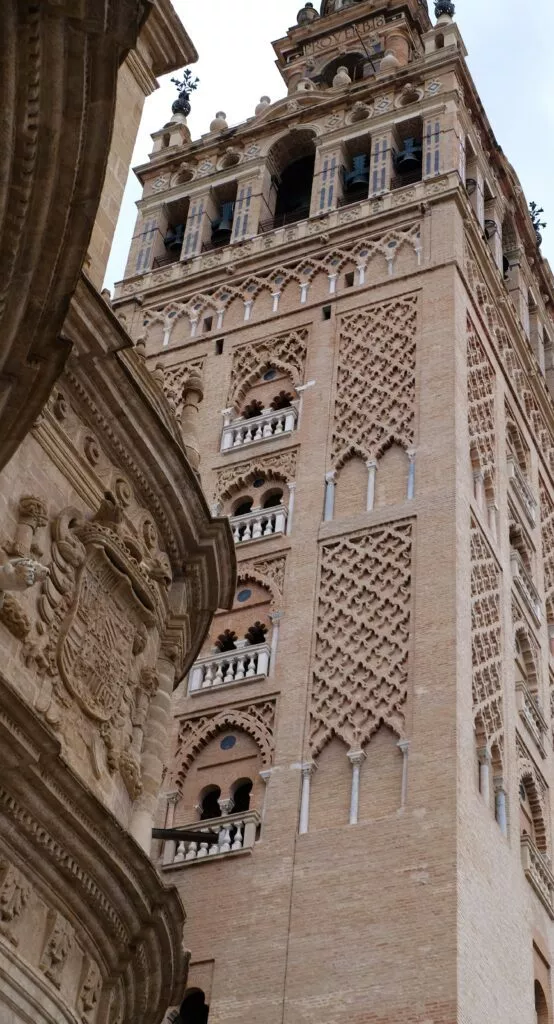
Finally, the Giralda owes its current name to the weather vane at the top, known as a giraldillo.
The giralda at the origin
Construction of the minaret – the current Giralda – began in 1184. It will be decorated with a yamur (see below). The structure of the minaret was not modified after the reconquest in 1248. However, an earthquake in 1356 caused the yamur to fall.
The Giralda will undergo a first transformation – on the right – before undergoing another which will give it its current form – in the center -.
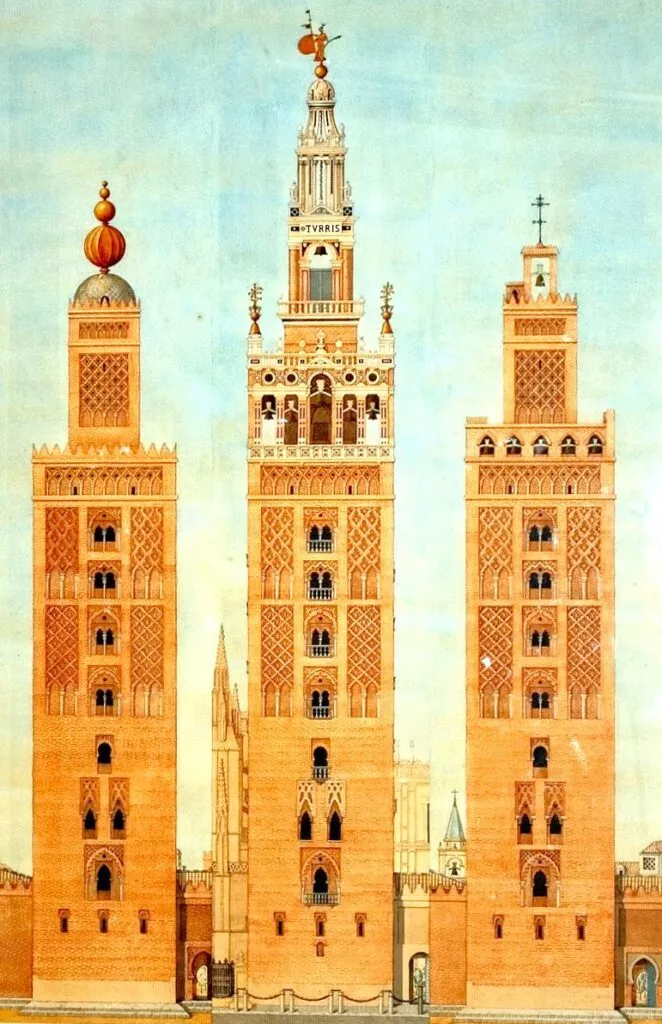
Note: the yamurs adorning the minarets are in most cases with three balls (an exception in Ishbylia). A legend says that they symbolize the three greatest prophets of Islam: Mohammed, Moses (Moussa) and Jesus (Īsā).
To book a ticket online to visit the cathedral and the Giralda.
Plaza de España – Spain Square – a must-see in Seville
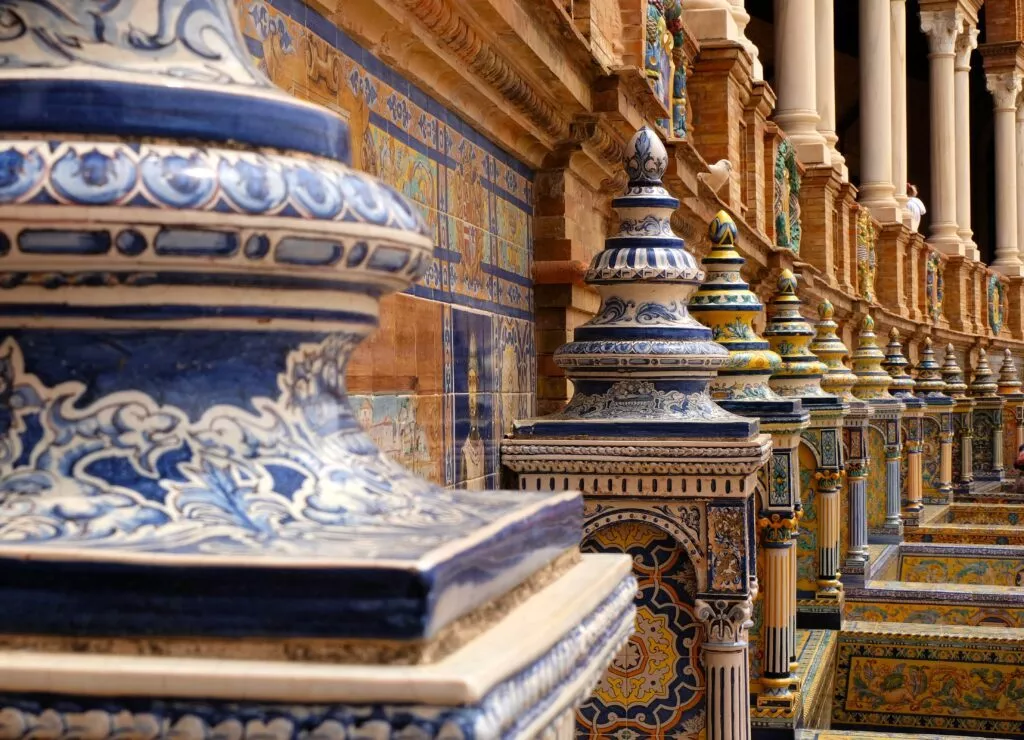
The Plaza de España is a monumental square built for the Ibero-American Exhibition of 1929. The square is surrounded by a triumphal arch and pavilions representing the different regions of Spain.
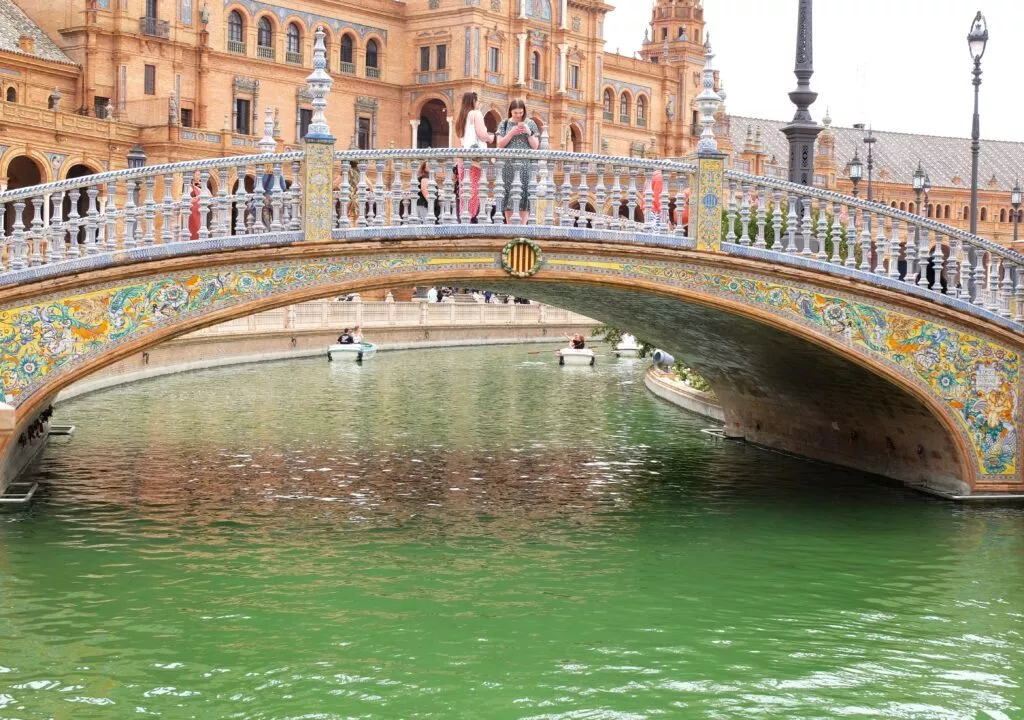
It is bordered on the inside by a small navigable canal crossed by 4 bridges symbolising the four ancient kingdoms of Spain (Castile, León, Navarre and Aragon). Anyone can hire a boat here.
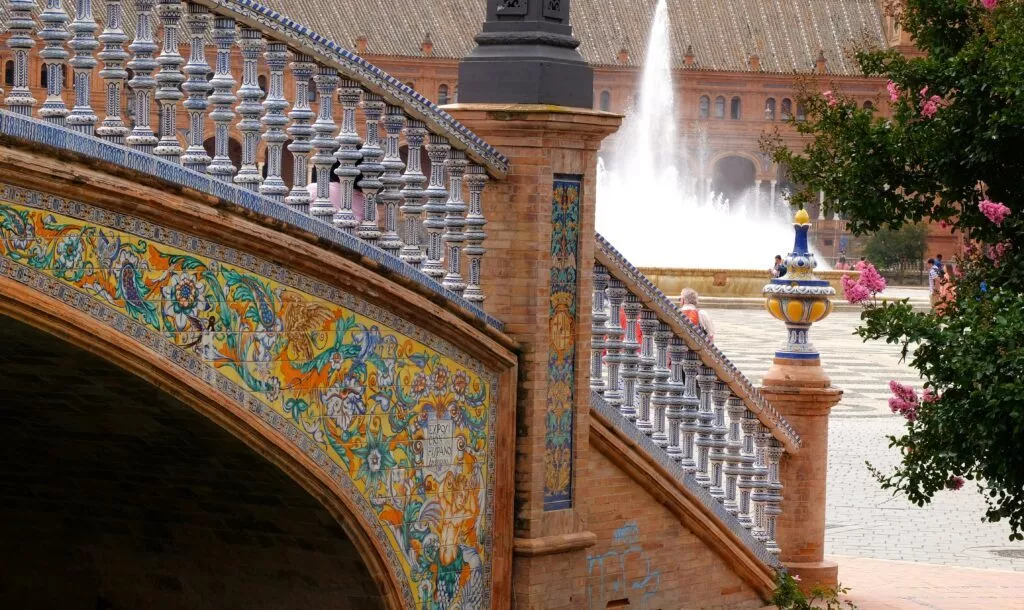
It has become one of Seville’s most iconic landmarks.
For film lovers, several films have been shot in this square:
- The Dictator by Sacha Baron Cohen
- Star Wars II: The Clone Wars, scene from the film on the planet Naboo
- Lawrence of Arabia
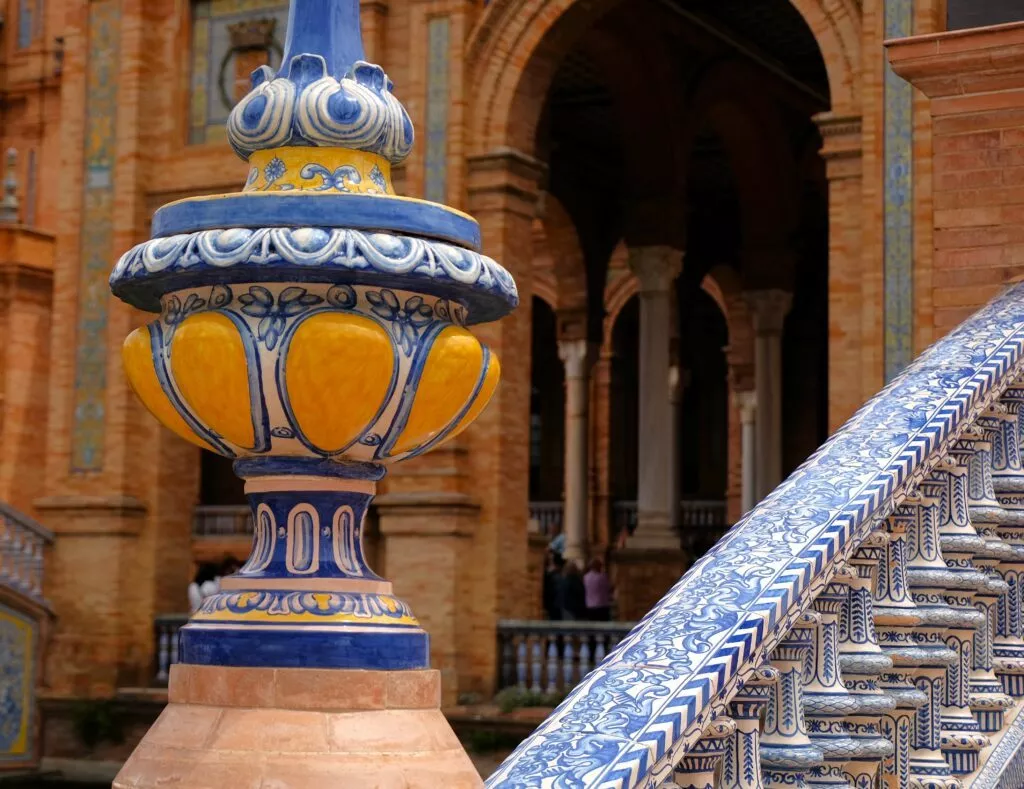
The architectural style of the Spanish Square is a clever blend of Andalucia’s regionalist architecture in brick and azulejos from Triana.
More specifically, the square evokes a Renaissance atmosphere with Mudéjar features.
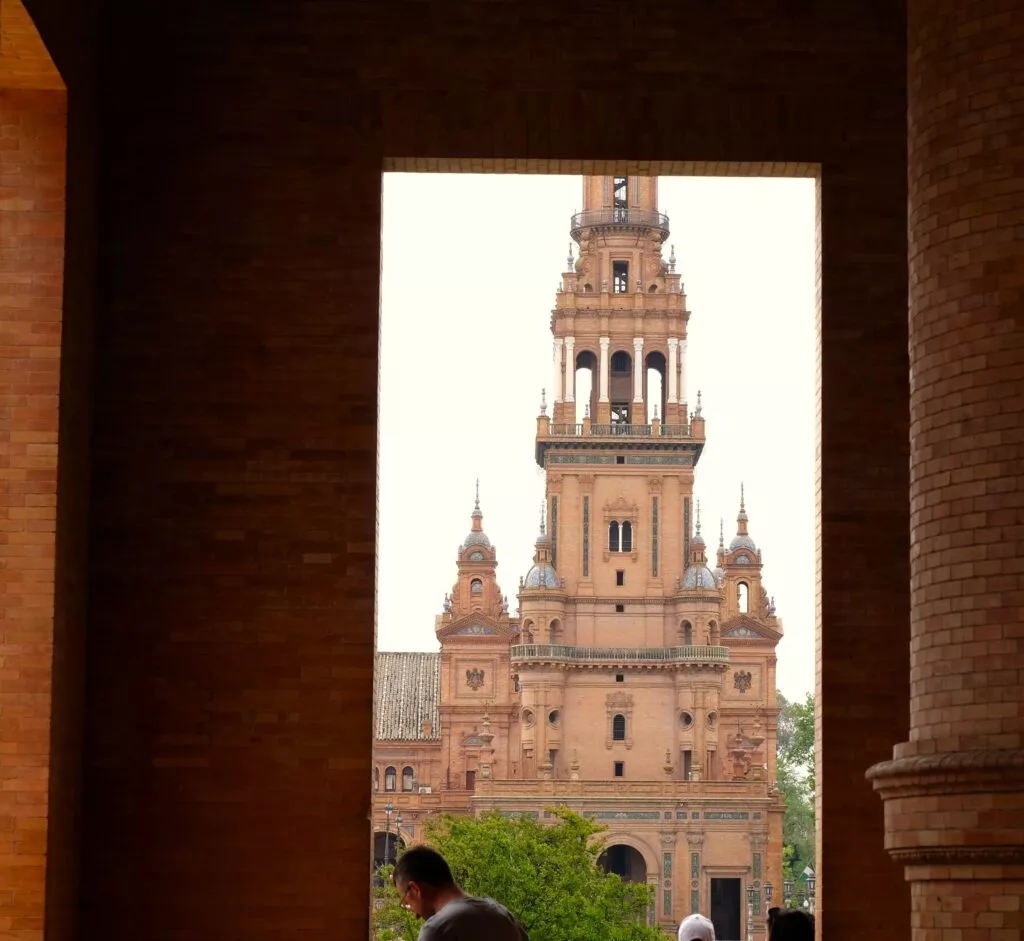
The shape of the square, intended by its creator, is semi-elliptical to evoke an embrace between Spain and Latin America.
Finally, in the Plaza de España, you can see flamenco shows every day:
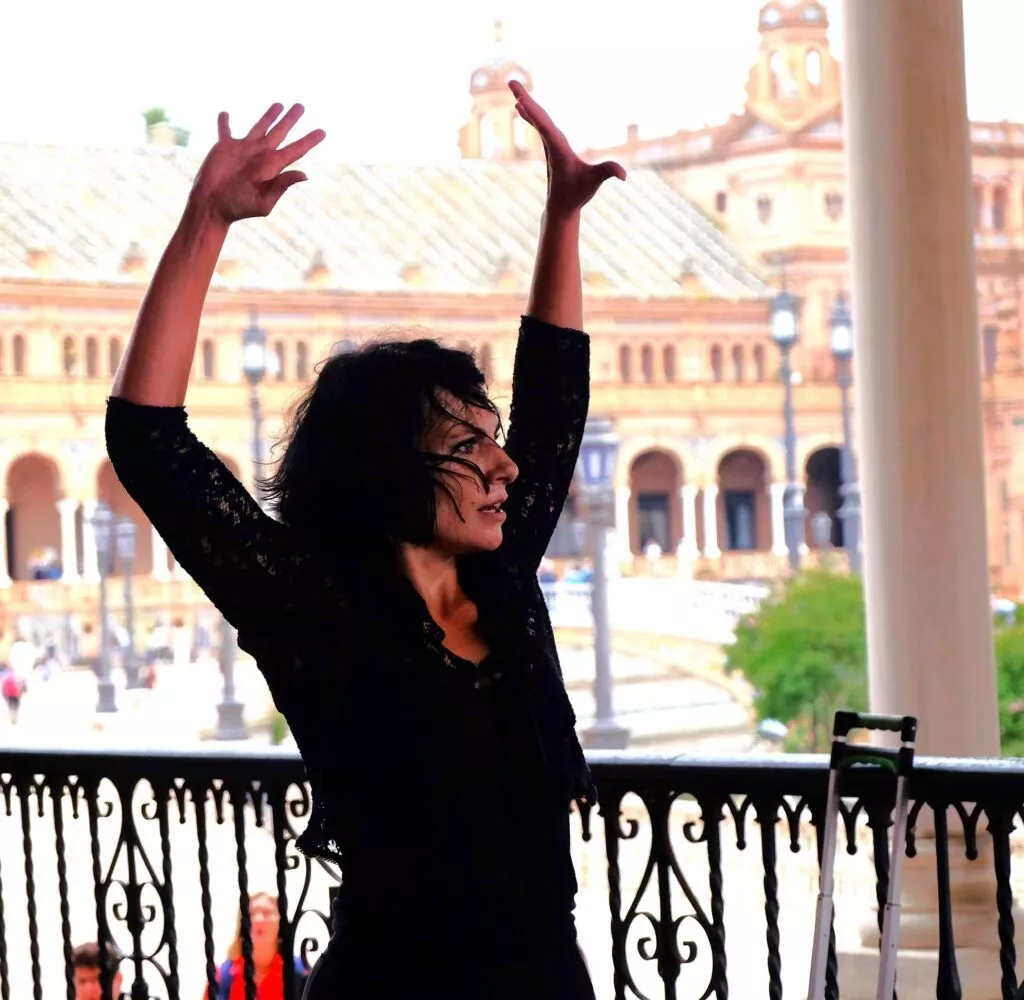
Walking through Seville’s shopping streets
It’s not possible to list all the shopping streets, but here are three in Seville’s city centre.
Calle Sierpes is a lively shopping street known for its boutiques, restaurants and bars.
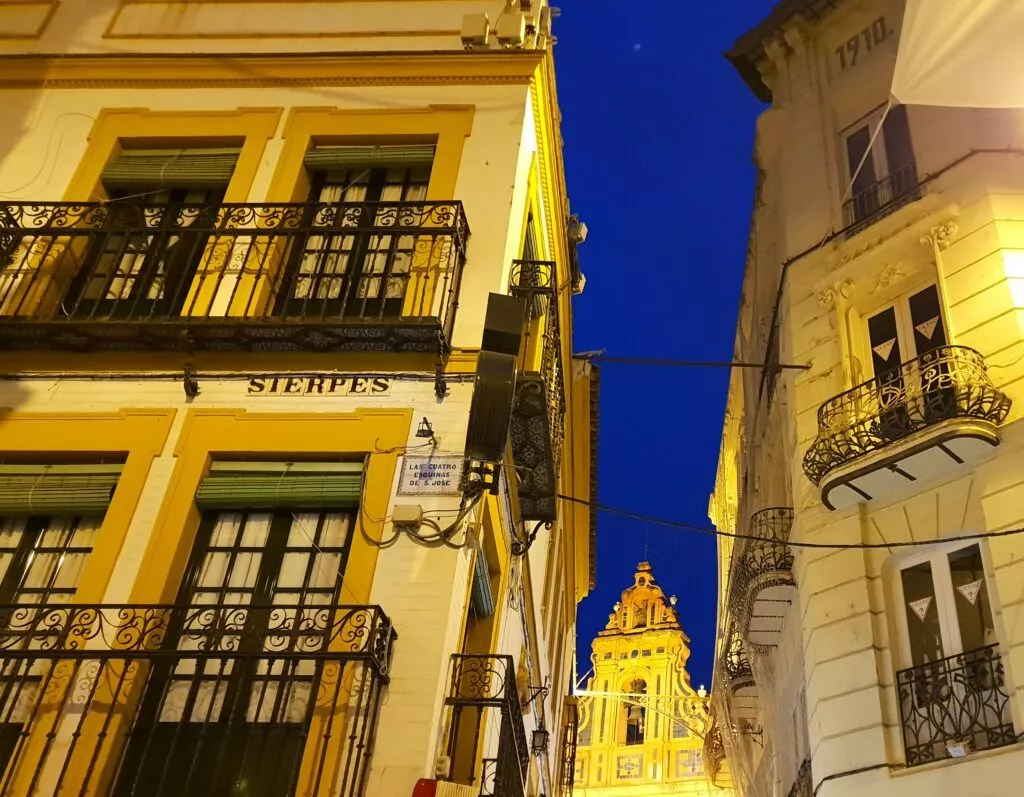
It is lined with historic buildings and is a great place to shop or just stroll.
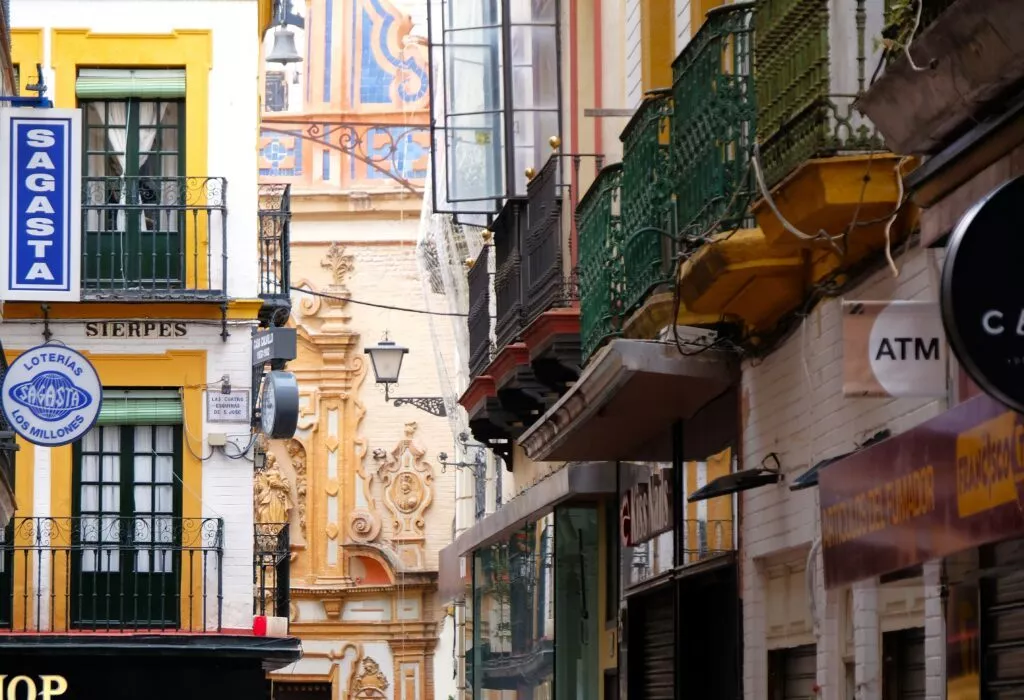
Calle Regina is another lively shopping street known for its luxury boutiques and souvenir shops. It’s a great place to go shopping or just for a stroll.
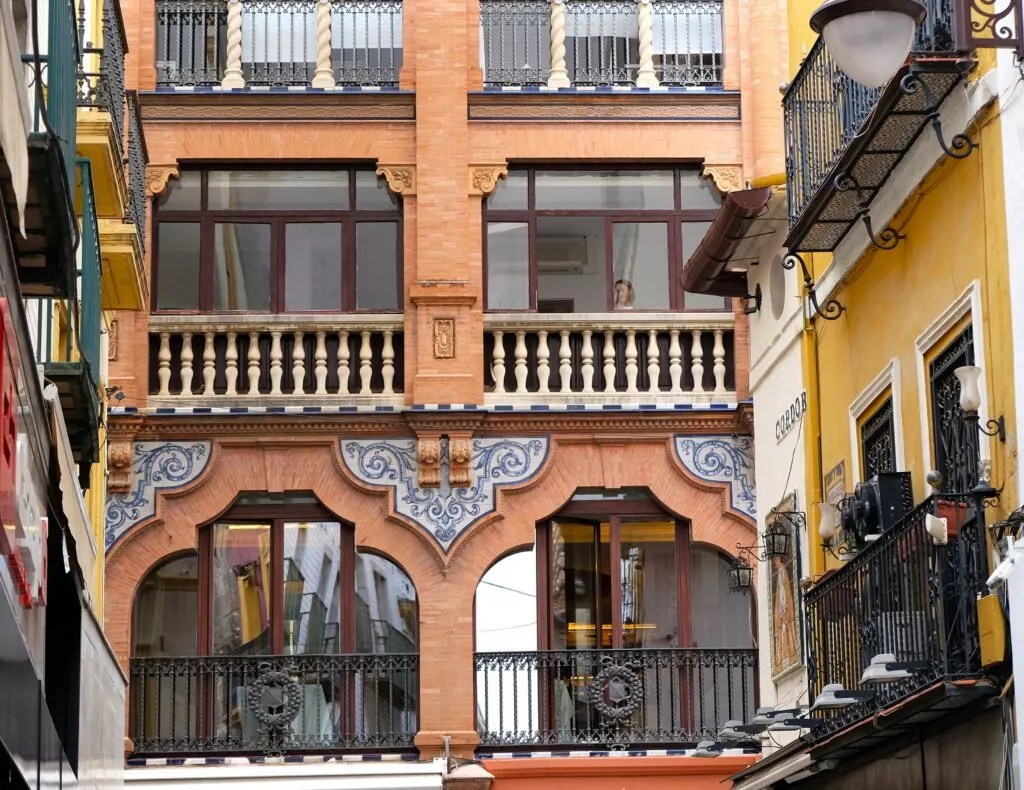
As for Calle Francos: this is a historic street known for its craft shops and traditional Andalusian restaurants. Lined with old buildings, it’s a great place to find unique souvenirs or simply enjoy the Andalucia atmosphere.
Abd-el-Aziz Tower and Postigo
The name of this tower and gateway – postigo – is a tribute to the Amir Abd al-Aziz ibn Musa, who lived in Ishbiliya (Seville) from 714 to 719.
The Postigo de Abd-el Aziz, built in the 13th century, is also known as the Arco de la Plata or Arco de la Victoria. Tower and Postigo Abd-el-Aziz are located on the Avenida de la Constitución, and formed part of the palatine wall of the Royal Alcazar of Seville.
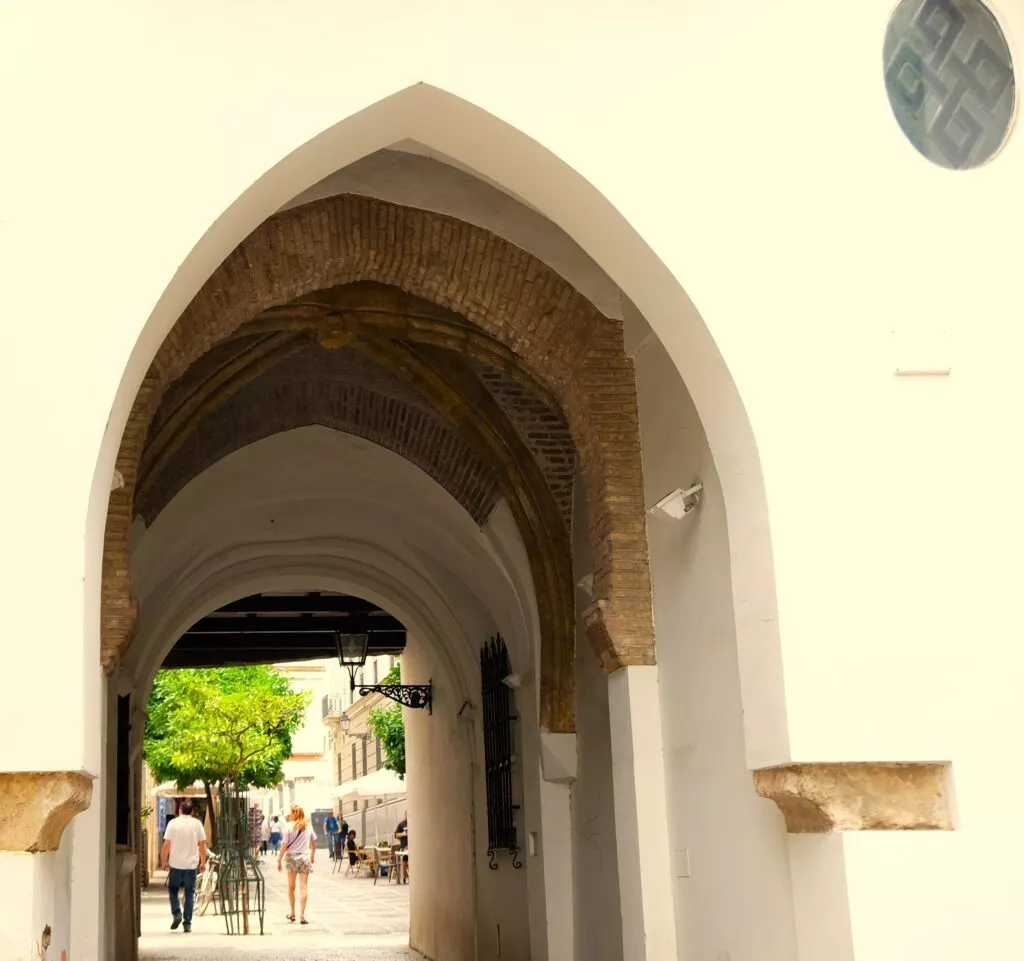
A more recent legend has it that it was also called the Torre del Homenaje, because it was here that the Castilian flag was first flown after the conquest of the city in 1248.
Las Setas – the Metropol Parasol – the new iconic place to visit in Seville
Here’s a place that has also become iconic in Seville despite its … very young age. The Metropol Parasol was inaugurated in March 2011.
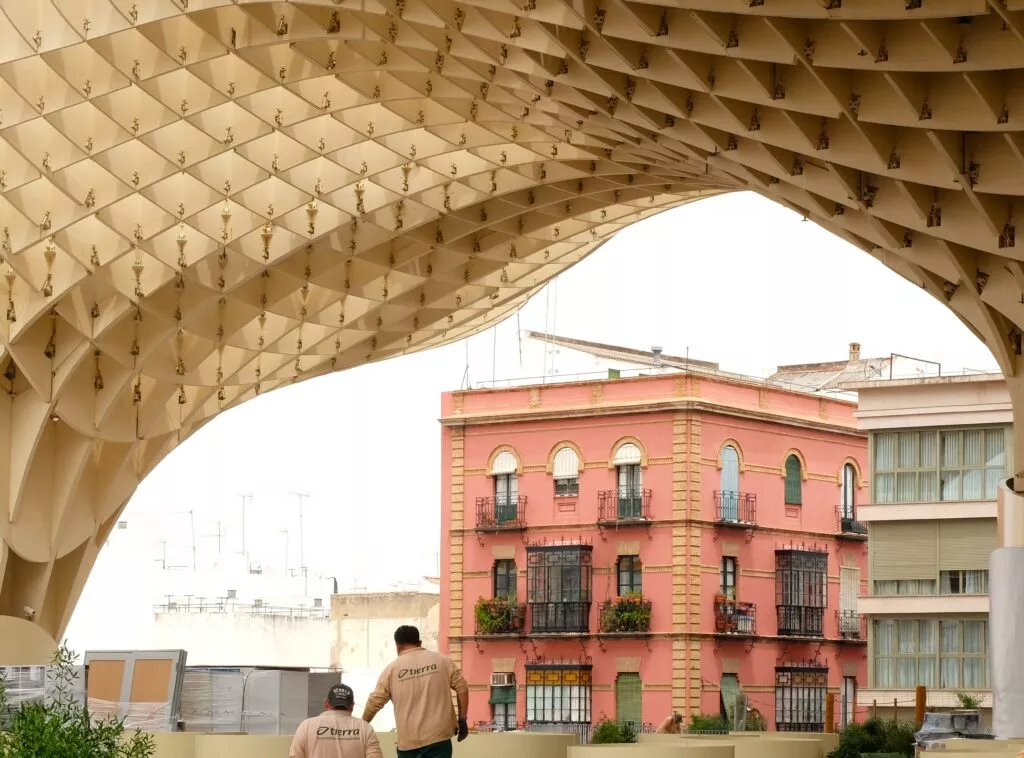
Its official name is the Metropol Parasol, but its shape (a huge wooden structure 150 metres long) quickly gave it another name:
Setas de la Encarnación (Mushrooms of the Plaza de la Encarnación) or Setas de Sevilla (Mushrooms of Seville).
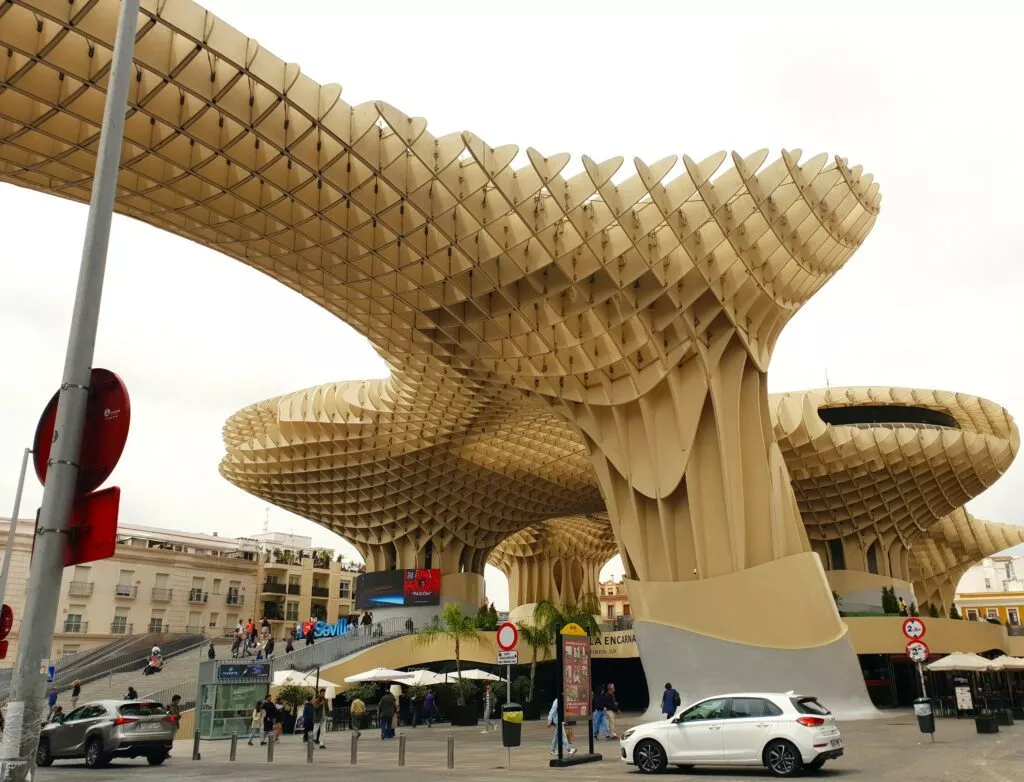
At the foot of the structure, there is a shopping centre and a number of restaurants. This is a reference to Seville’s old and great food market – it had 400 stalls! – which was held for a long time on this Plaza de la Encarnación.
You can also walk around the top of the structure to enjoy magnificent views over Seville, simply by booking a ticket for the Metropol Parasol.
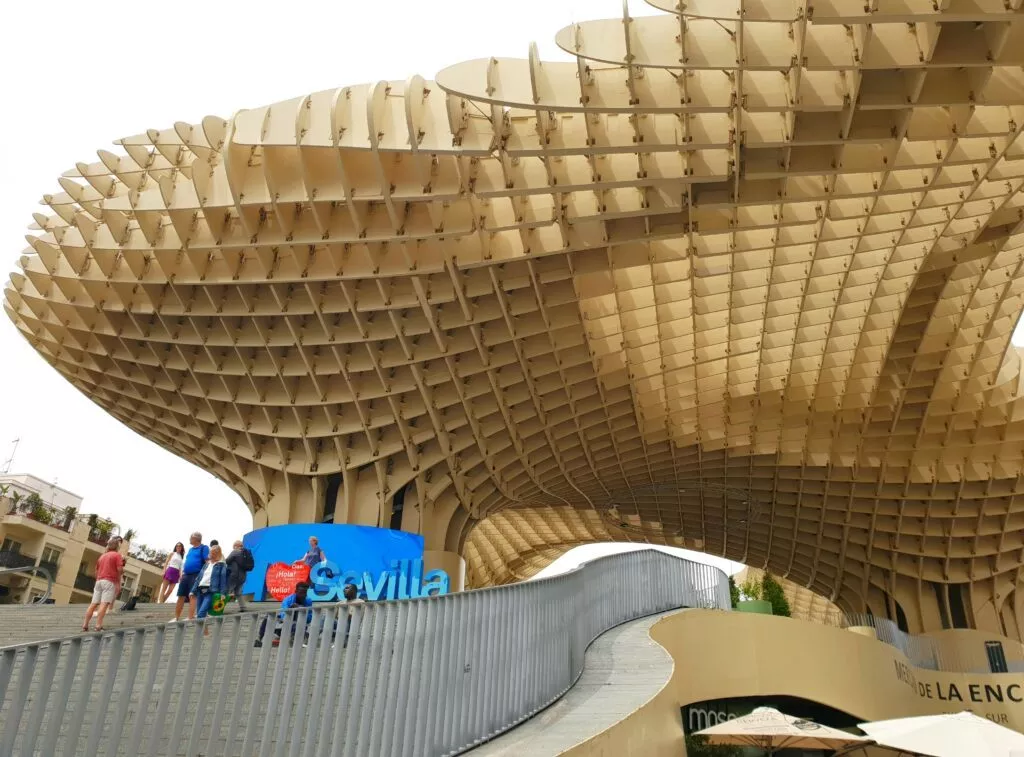
Ironically, this Seville landmark should never have seen the light of day. The original plan was to build a car park, but the project was aborted following the discovery of Roman ruins.
Good to know: if you have bought a ticket to visit the Alcázar, you can visit this underground site, called the Antiquarium, free of charge. Located in the basement of the Metropol Parasol in Plaza de la Encarnación, it is the most important archaeological site preserved from Roman times in Seville.
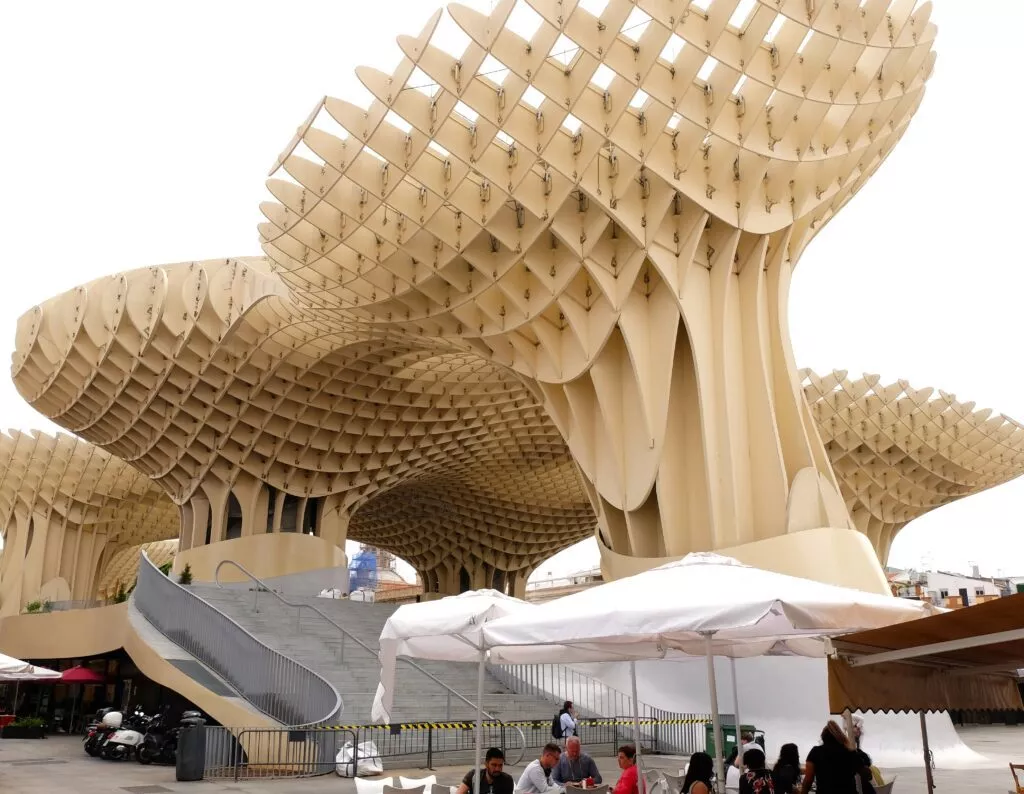
La Torre del Oro – Tower of gold –
The Torre del Oro is a watchtower built by the Moors in the 13th century. The Torre del Oro is the most famous of the remaining towers of Seville’s fortified walls. Built between 1220 and 1221, it owes its name to the golden effect its colour originally produced when reflected in the Guadalquivir.
The main function of the Torre del Oro was to serve as a defensive bastion at the entrance to the port of Seville. The Torre del Oro is now a maritime museum.
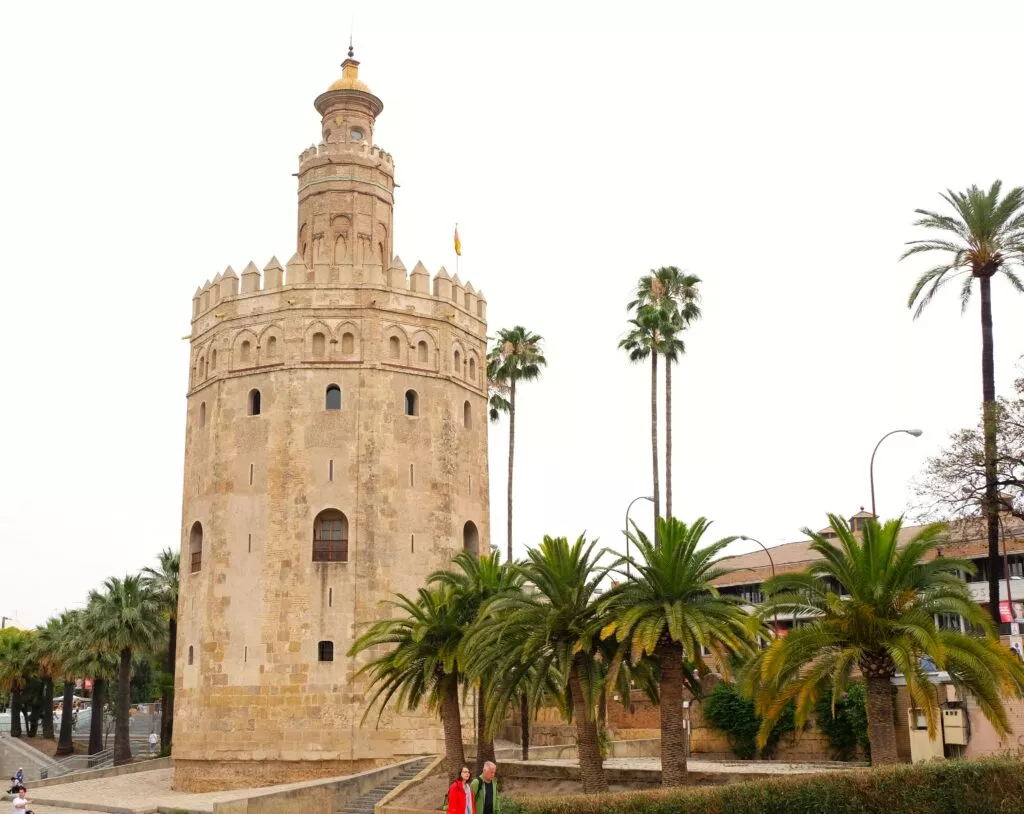
This m onument, Torre del Oro, was originally linked to the Torre de Plata – which is rarely mentioned and can be seen in what is now Calle Santander – by a wall that has now disappeared. It formed part of the defensive complex to the south of the city and the port.
Maria Luisa Park… a French story…
The Parque María Luisa, just off the Plaza de España, is Seville’s main green lung. It is also one of the most beautiful parks in Spain and one of the most popular spots in the city. People come here to cool off too.
This magnificent space, inaugurated in 1849, was designed by a French engineer: Jean-Claude Nicolas Forestier. The irregular layout of the park’s 40 hectares was inspired by wild romantic love, according to its creator.
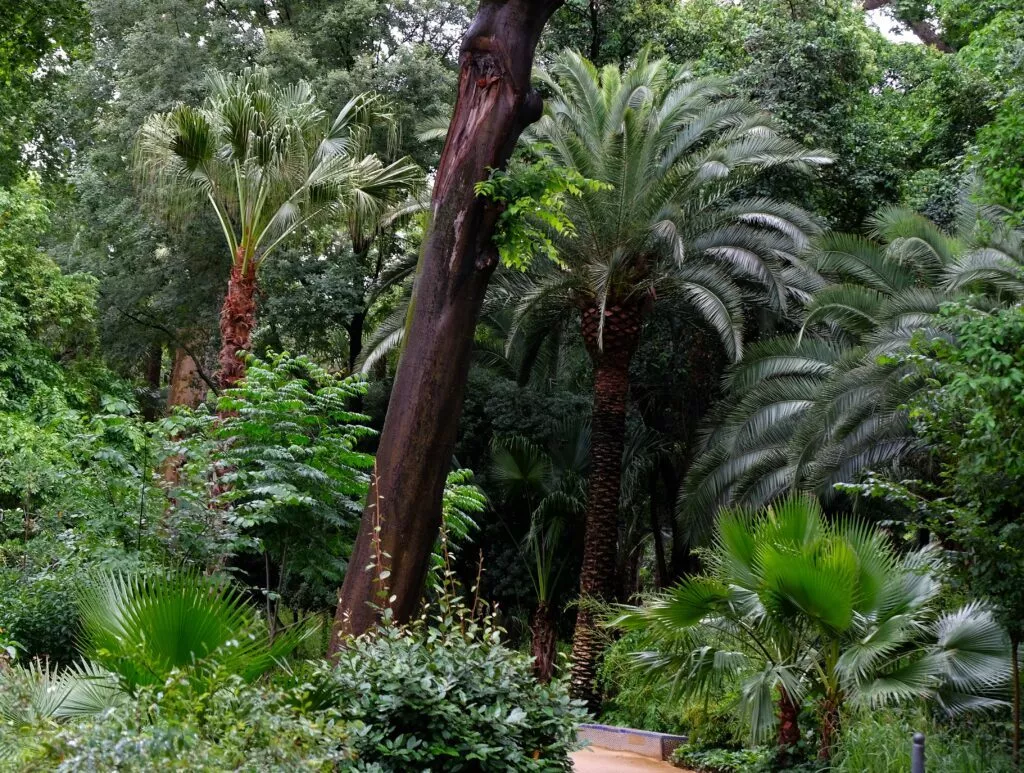
It’s arguably the best walk, stroll, on foot in Seville when it’s hot…which is often 🙂 .
He created it in collaboration with gardener André Lecolant, who was the curator of the Bois de Boulogne in Paris.
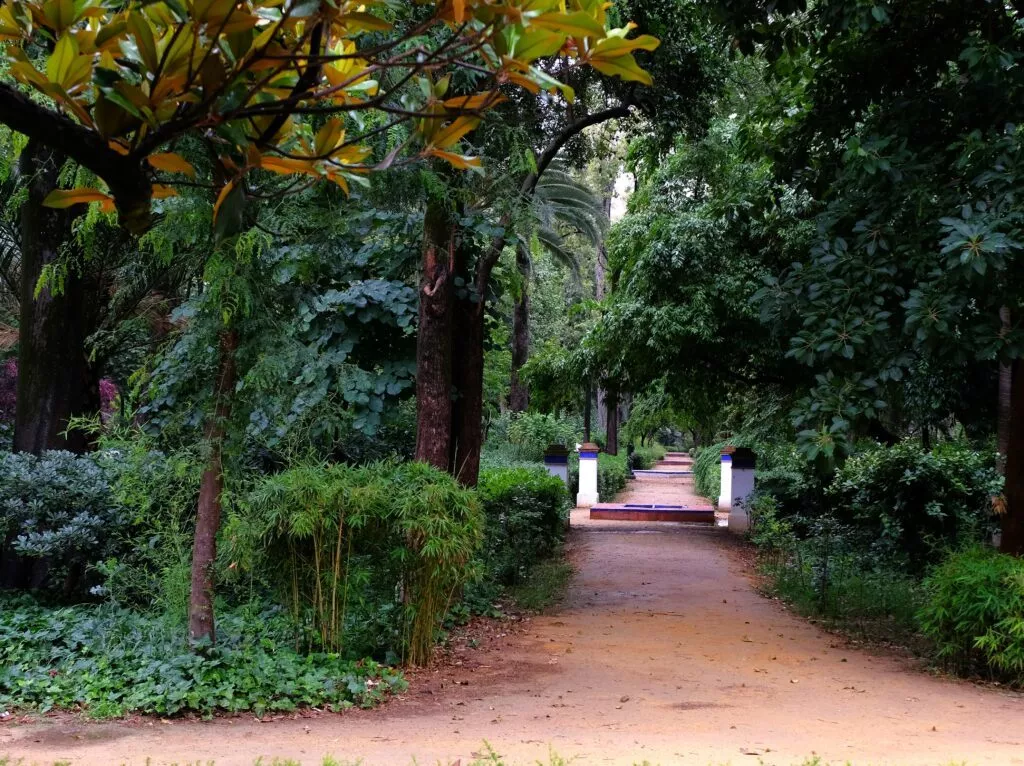
Here are the most emblematic places in the Maria Luisa Park:
- the Glorieta de Bécquer,
- Isla de los Pájaros,
- Monte Gurugú
- Plaza de América.
Note: this park was not opened to the public until 1914. From 1849 to 1914, it belonged to Antonio de Orléans, Duke of Montpensier, and his wife, María Luisa de Borbón. On the death of her husband, María Luisa donated the gardens to the capital of Seville, which gave them the name of Parque María Luisa.
The Casa de Pilatos – Pilate’s House – a little treasure to discover in Seville
The Casa de Pilatos is a medieval palace dating from the 14th century. It was built in a Mudejar and Renaissance style. The Pilate’s house currently belongs to the House of Medinaceli.
It is entered through a white marble portal, designed by Antonio María Aprile in Genoa in 1529. A Renaissance-style portal in the style of a triumphal arch,
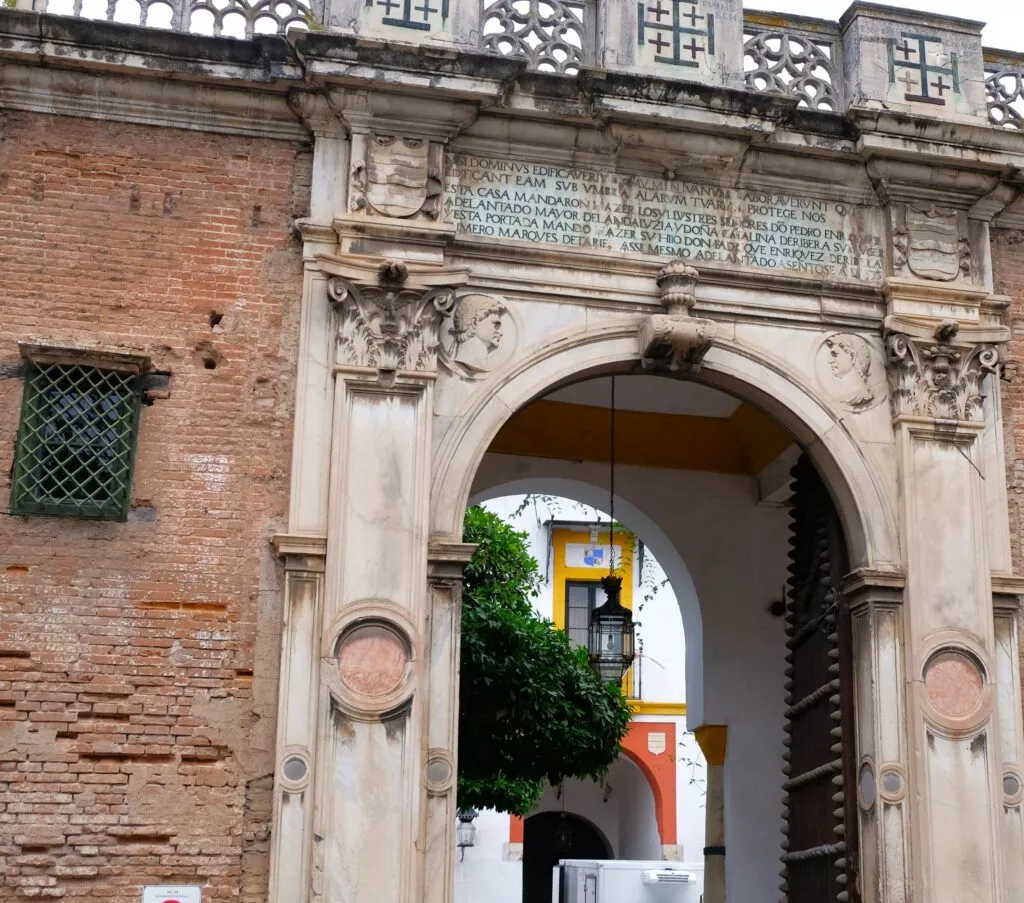
The great influence of the Italian Renaissance is closely linked to Fadrique Enríquez de Ribera. He was the son of the owners and the first Marquis of Tarifa. In 1518, he crossed Italy on a pilgrimage to Jerusalem. During this trip, he was deeply influenced by the art of the Italian Renaissance.
The palace also houses an important collection of paintings, sculptures and other works of art. At the centre of the palace is an incredibly beautiful courtyard and patio.
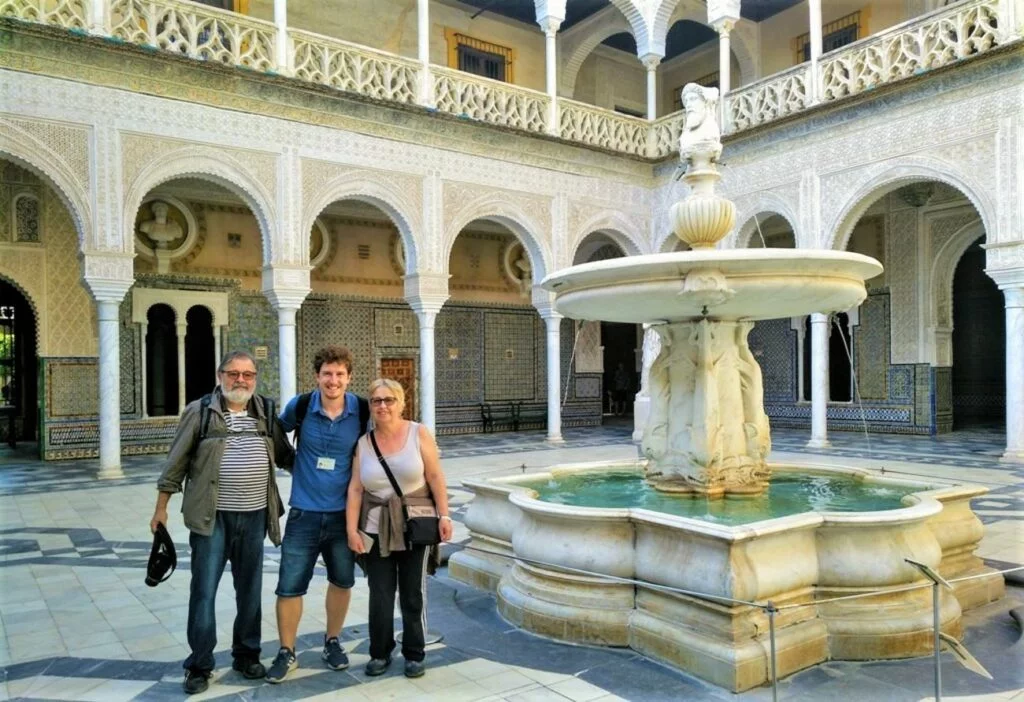
There is a beautiful legend about the origin of the name Casa de Pilatos:
On his return from his pilgrimage, the Marquis is said to have taken over many of the features of the palace of the Roman praetor Pontius Pilate in Jerusalem. This legend gave rise to the name Casa de Pilatos.
In fact, the portico facing outwards on the first floor next to this façade is sometimes called the balcony of the Ecce Homo, as it is said to reproduce the space where Jesus was shown to the people in the famous passage from the Bible.
Note to film buffs: several films have been shot in the Casa de Pilatos, including Lawrence of Arabia and Knight and Day, as well as an episode of the 5th season of the Netflix series The Crown. Ridley Scott also shot scenes from two films there: 1492: Conquest of Paradise and Kingdom of Heaven.
The Plaza de Toros – La Real Maestranza de Caballería
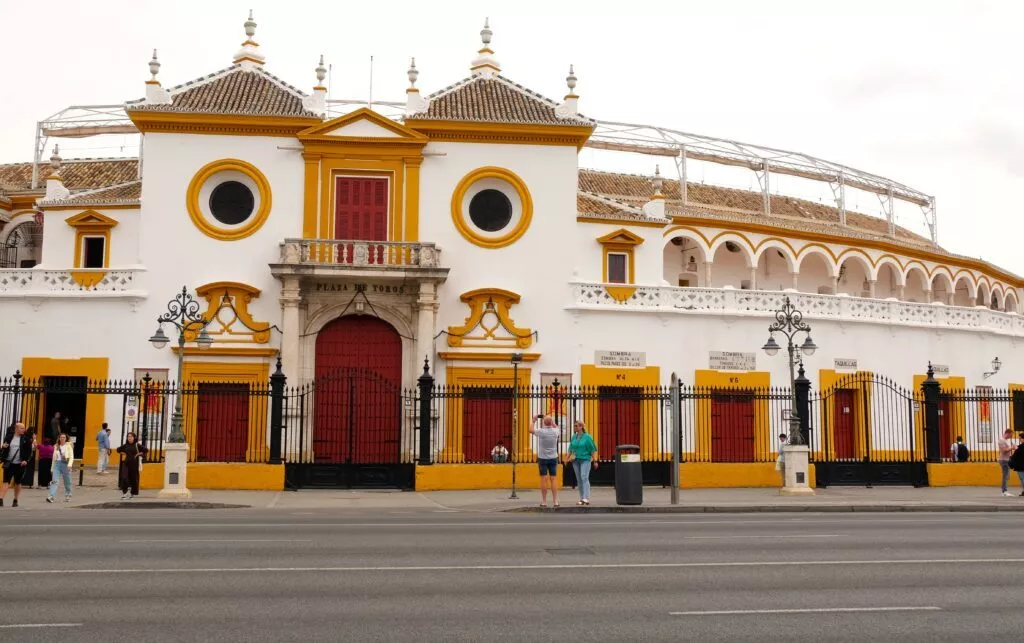
The Real Maestranza de Caballería is a bullfighting arena built in the 18th century. It is one of the oldest and most prestigious bullfighting arenas in Spain.
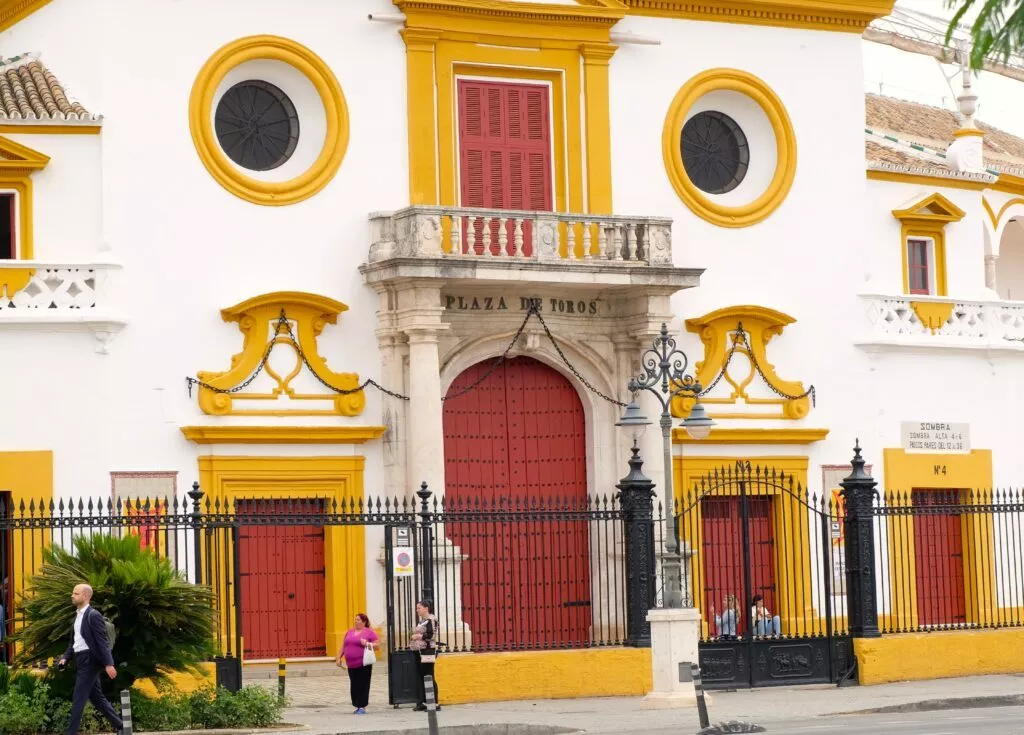
The arena is located right next to the El Arenal port district, and has a capacity of 13,000 spectators. Originally built of wood in 1733, it was the first circular (oval) bullring in Spain.
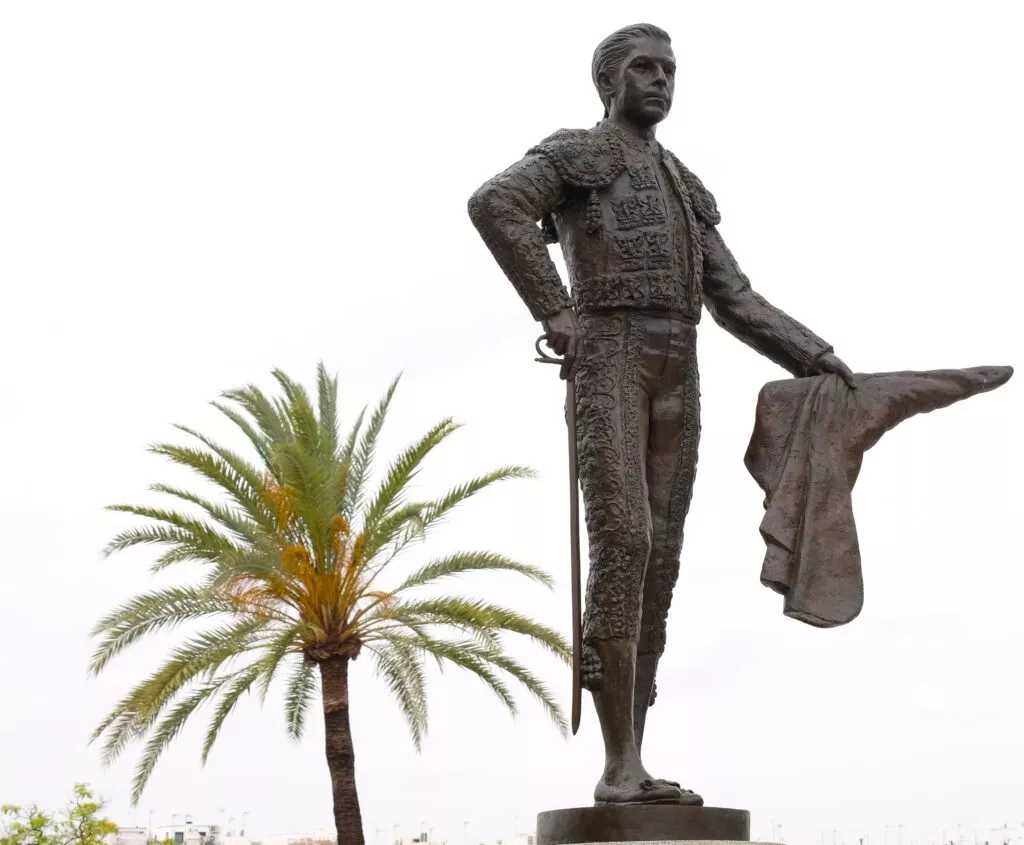
The Plaza de Toros de la Real Maestranza de Caballería de Sevilla is considered to be the bullring with the longest bullfighting tradition in Spain. It is popularly known as the “Catedral del Toreo“.
Church of the Saviour – Iglesia del Salvador – hidden gem to see in Seville
Here’s one of my favourite places in Seville: the Church of the Saviour – Iglesia Colegial del Divino Salvador – along with the Plaza Jesus de la Pasión, popularly known as the Plaza del Pan (Bread Square).
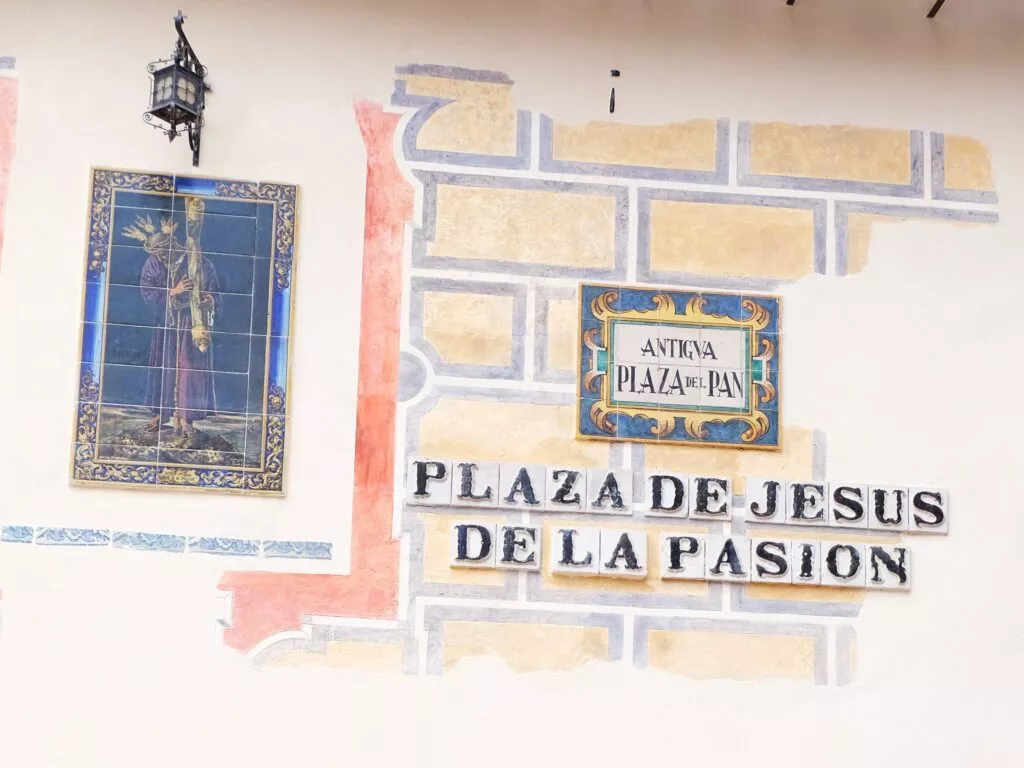
First, a little history of the Church of the Saviour
The Church of the Divine Saviour was built on the site occupied by the Ibn Adabbas mosque. It was the first major mosque in Seville, built in 829-830 by the city’s cadi, Umar ibn Adabbas, at the request of Abd al-Rahman II.
A vestige of this Arab architecture can still be seen on one side of the church, at the base of the former minaret.
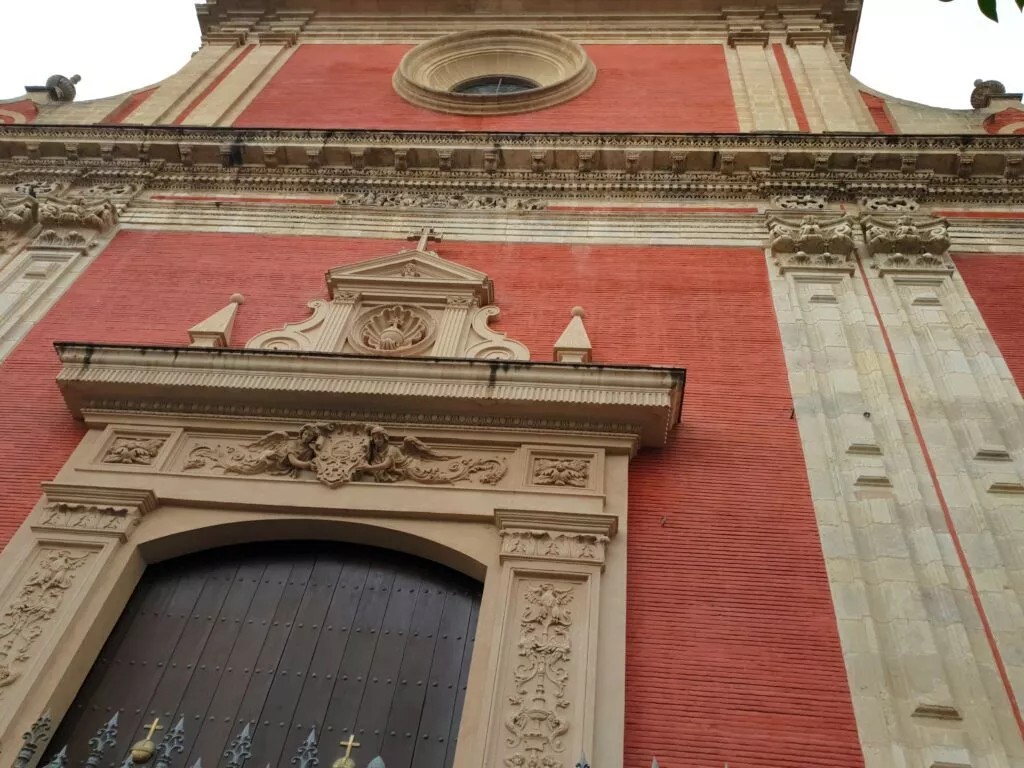
I found the interior of this church, the second largest Christian temple in Seville after the Cathedral, incredibly beautiful, especially the dome:
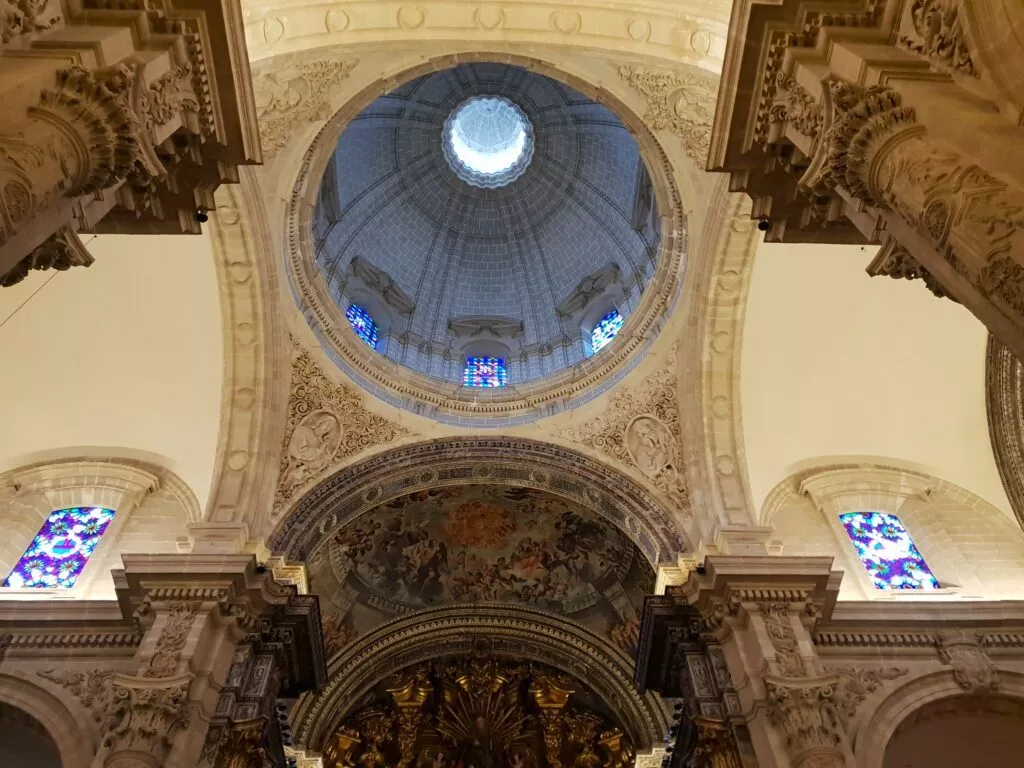
What’s particularly interesting is to spend some time visiting and looking at the 5 chapels and 14 altarpieces (the one of the Virgin of the Waters and that of Juste and Rufine are splendid) that make up this church.
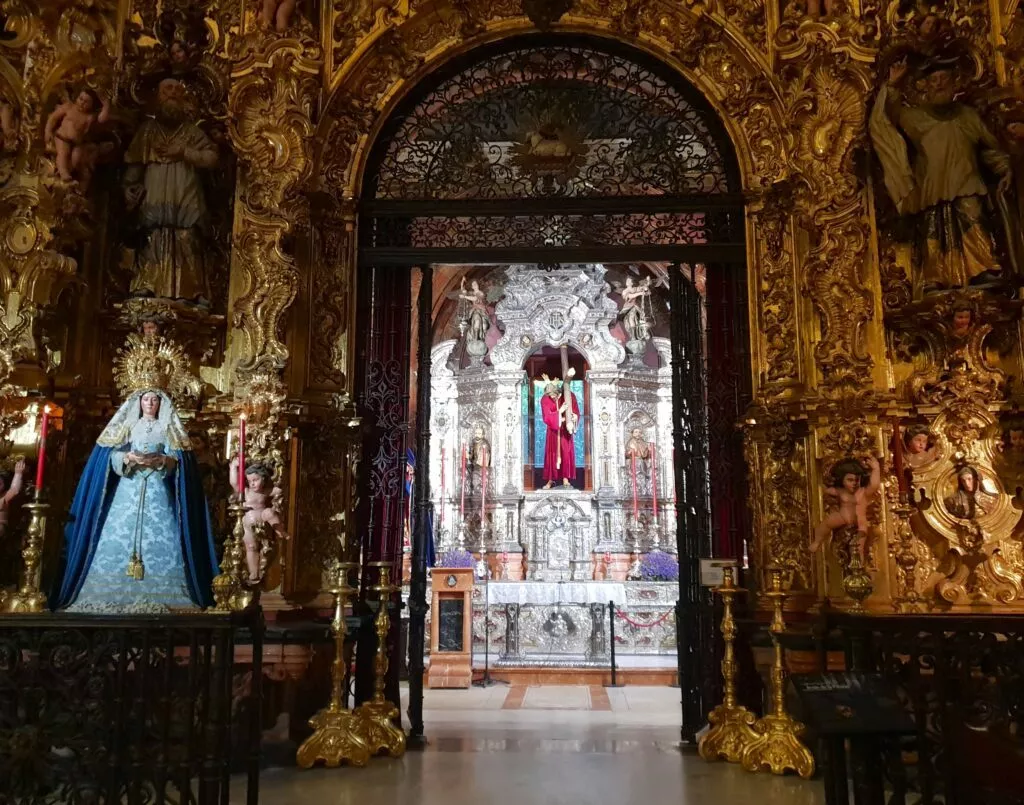
Each altarpiece is accompanied by an informative panel.
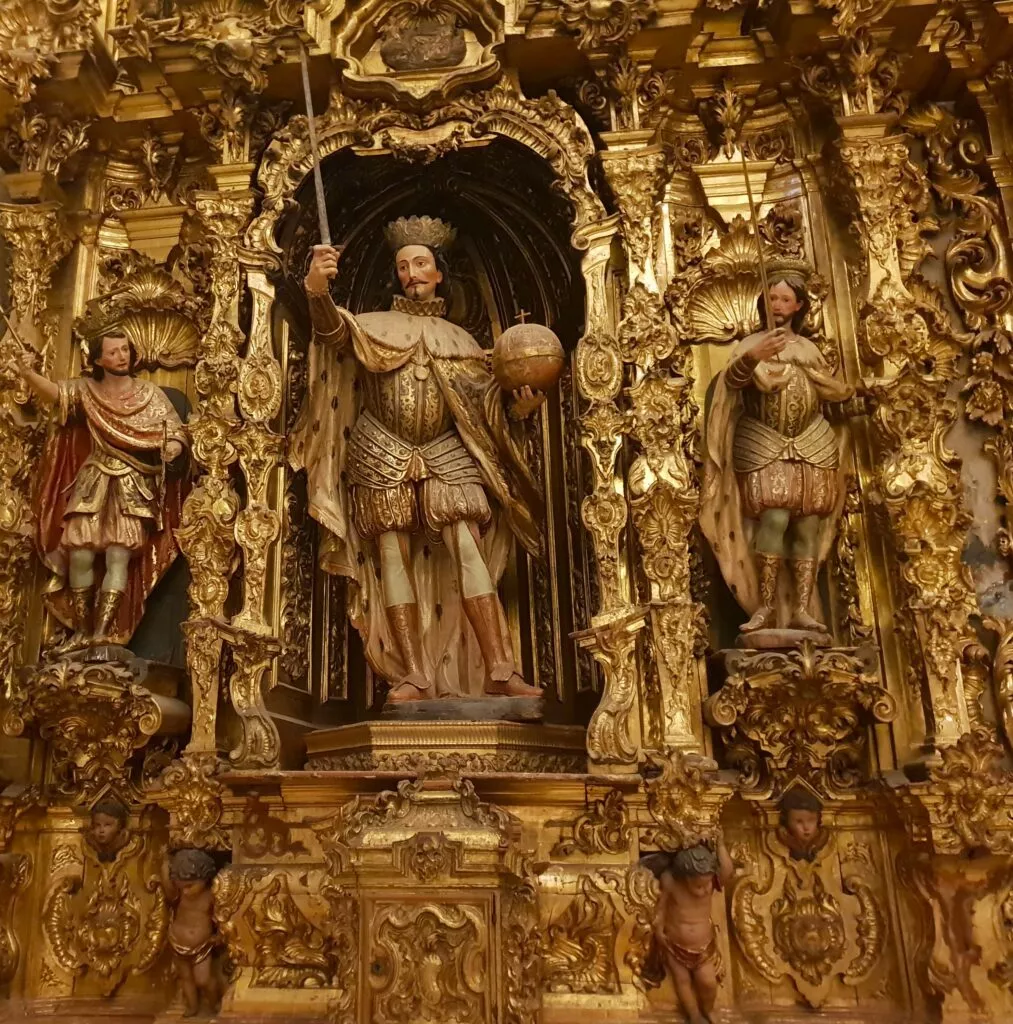
Finally, a word about the Plaza del Pan, whose official name is Plaza Jesús de la Pasión:
During the Almohad period, the Plaza del Pan was part of the souk of the Ibn Adabbas mosque. Foodstuffs such as fish, bread and vegetables were sold here. This market tradition has lasted for centuries in this part of La Alfala.
The Basilica of La Macarena
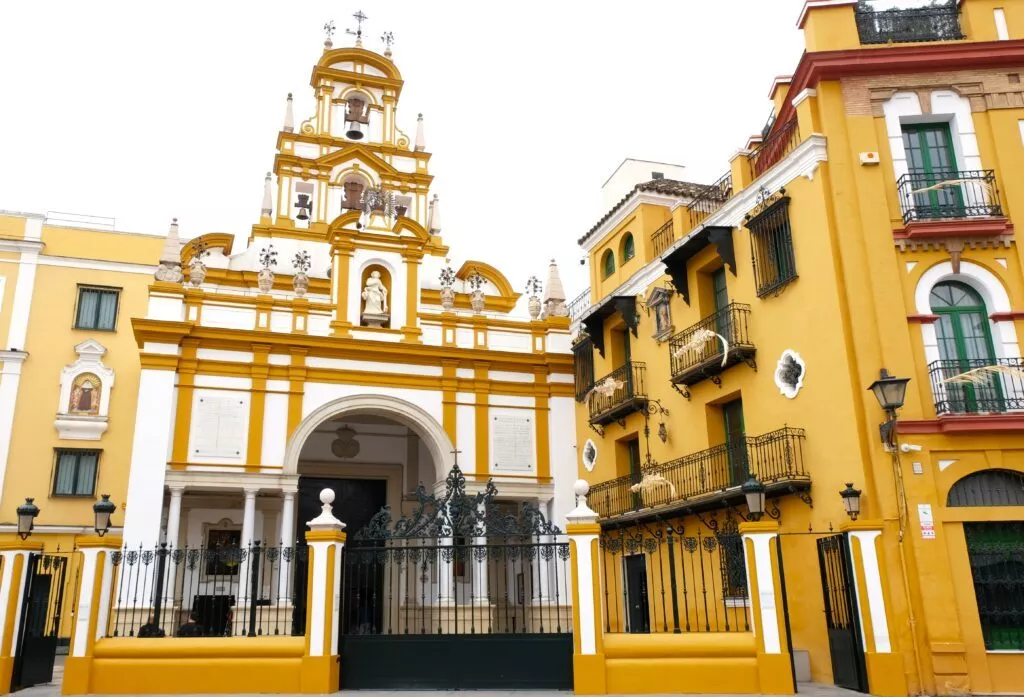
The Basilica de la Macarena is a Catholic church in the San Gil district of central Seville.
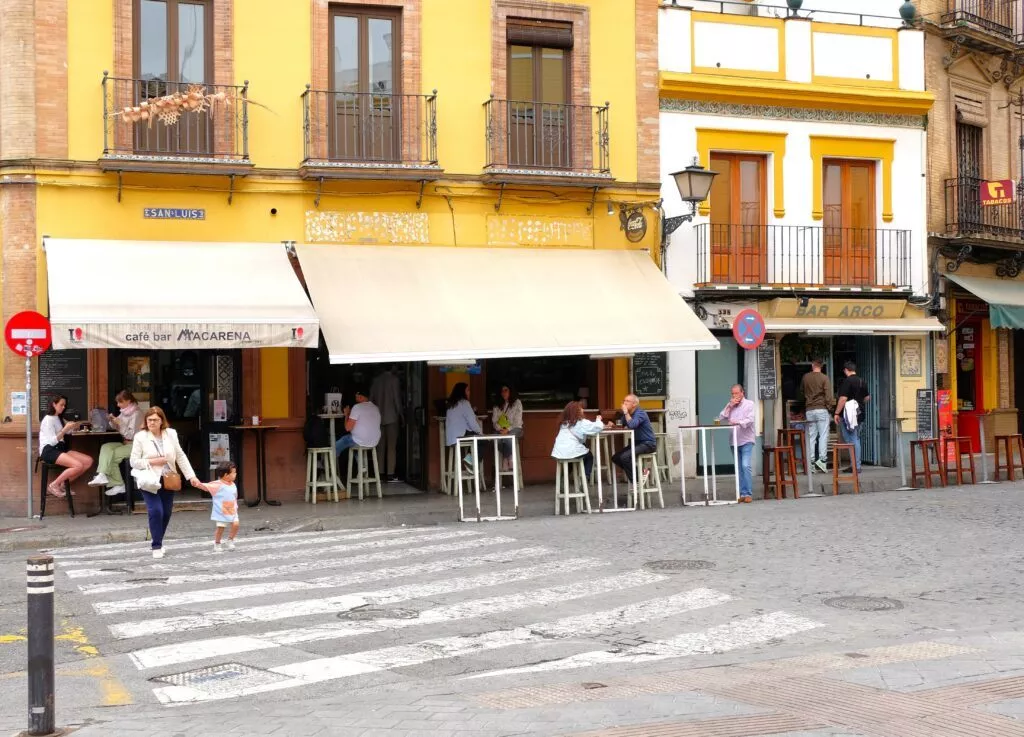
It stands directly opposite the popular La Macarena district.
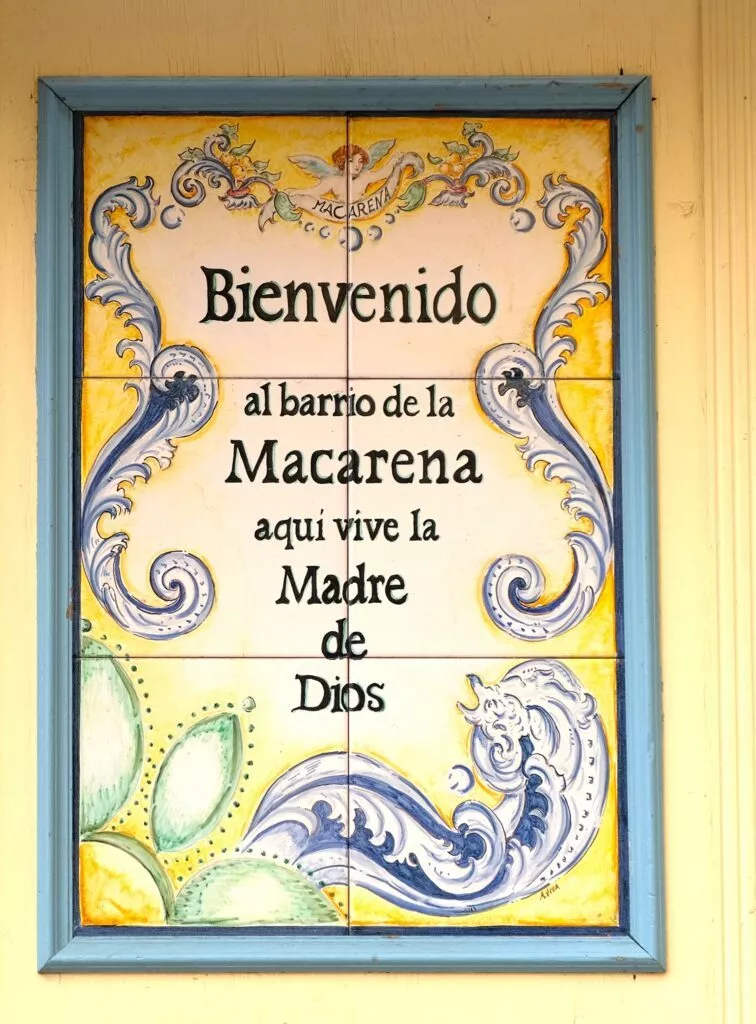
The basilica is dedicated to the Macarena Virgin of Hope, a statue of the Virgin Mary that is one of the most venerated in Spain.
The basilica is a popular place of pilgrimage for Sevillian worshippers and is often used for religious and cultural events, such as Holy Week.
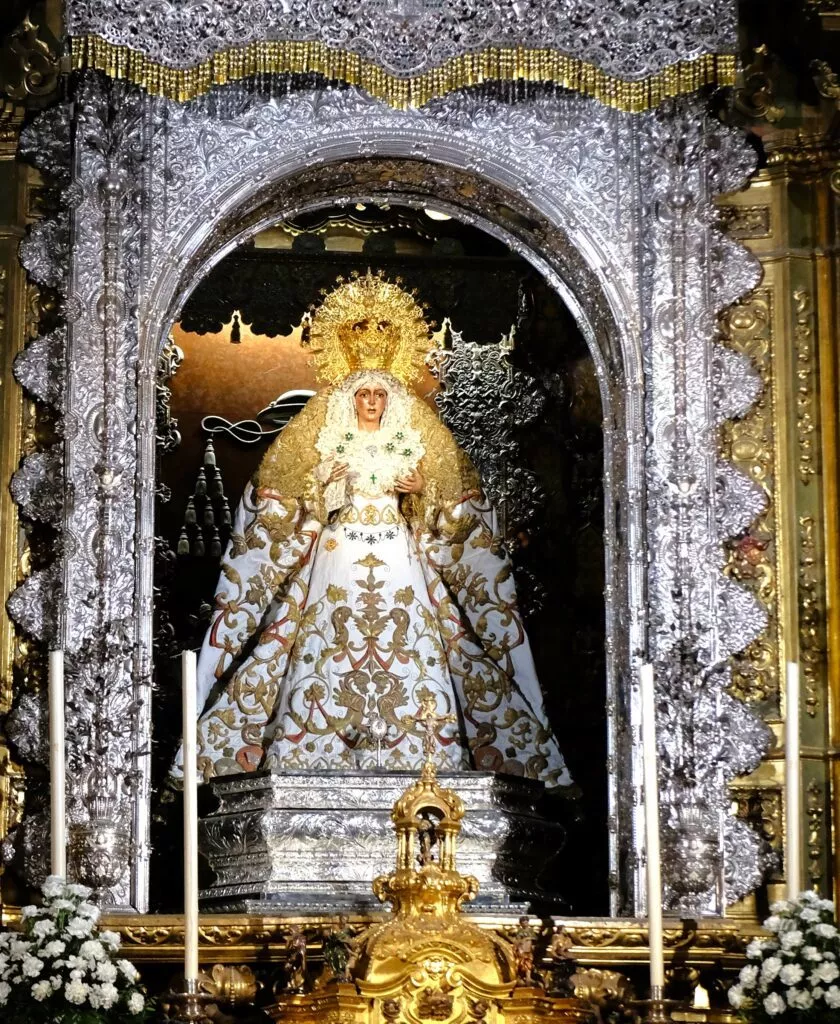
In fact, during Holy Week, the Virgen de la Esperanza Macarana went out in procession along a route filled with rose petals!
La Virgen de la Macarena is also an imagen that inspires devotion the world over, particularly in Latin America.
The basilica, built in the late 1940s in a neo-baroque style, is sumptuously decorated with paintings, sculptures and stained glass windows.
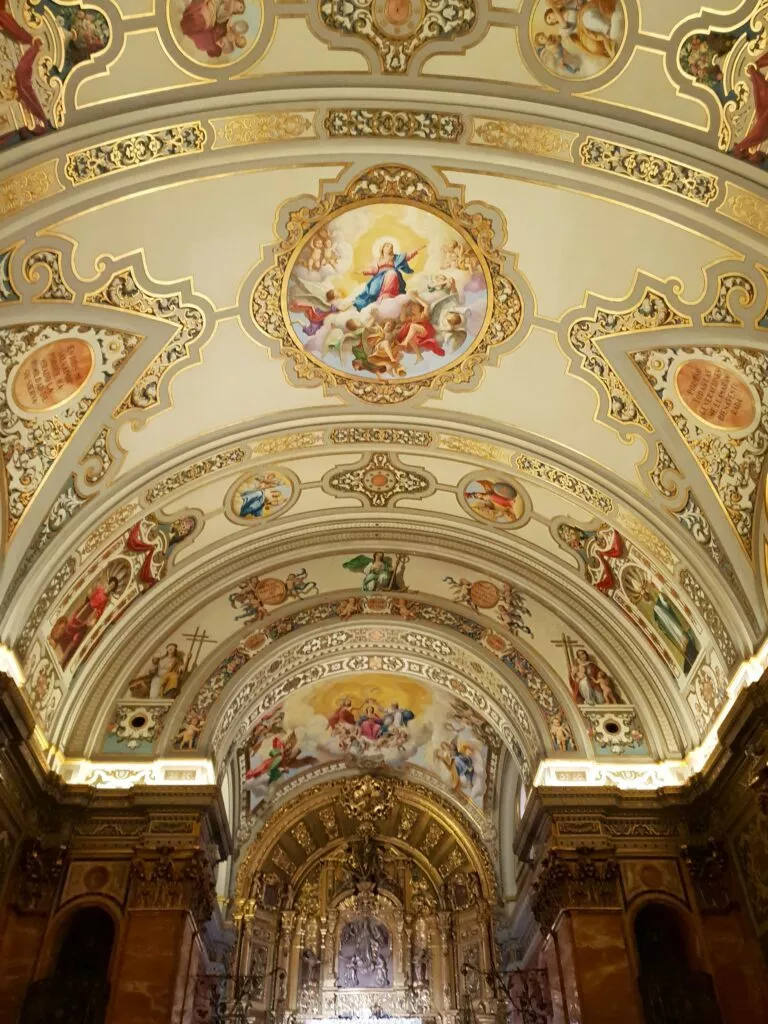
The statue of the Virgin of Hope Macarena, on the other hand, is a much older wooden statue, dating from the mid-seventeenth century. It depicts the Virgin Mary with a face of pain and five tears – crystal tears – running down her cheeks.
The Virgin of the Macarena in Seville is much celebrated by the people of Andalucia and Spain:
- García Lorca wrote a few verses to her:
- ahora mismo en Sevilla
- visten a la Macarena
- Manuel Machado – poet and brother of the poet Antonio Machado – also wrote:
- Virgen de la Esperanza!
- Macarena!
- Y una explosión de sol y de armonía,
- y un fluir generoso de alegría
- she also holds a special place for gypsies
- she is also the patron saint of bullfighters,
Note: The statue of the Virgin still bears 5 emerald brooches donated by the famous bullfighter Joselito. Bullfighters have long made offerings to the Virgin to protect them in the ring. When the famous gypsy bullfighter José Gomez Ortega, known as Joselito, died in the bullring in 1920, the Virgin was dressed in black for the first and only time in history.
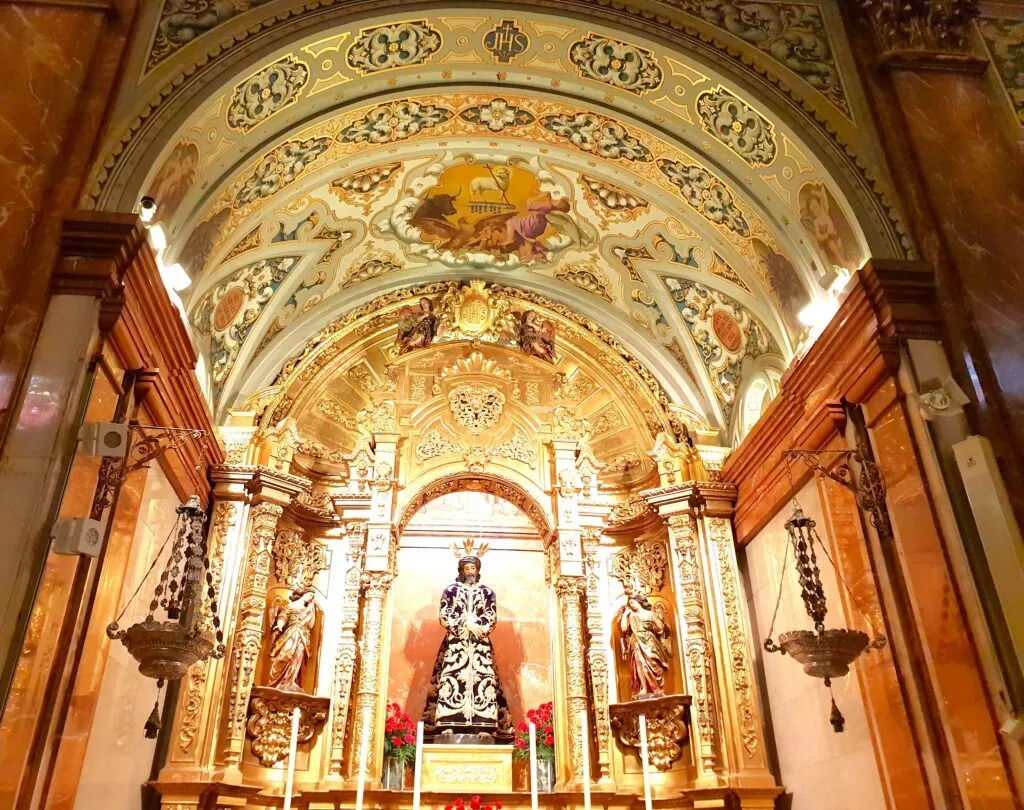
Puerta de la Macarena next to the Basilica de la Macarena
The Puerta de la Macarena, whose appearance has changed over time, is one of only three entrances to the 12th-century walls built by the Almoravid sultan Ali ibn Yusuf that still exist today. The other two entrances are the Cordoba Gate and the Postigo del Aceite.
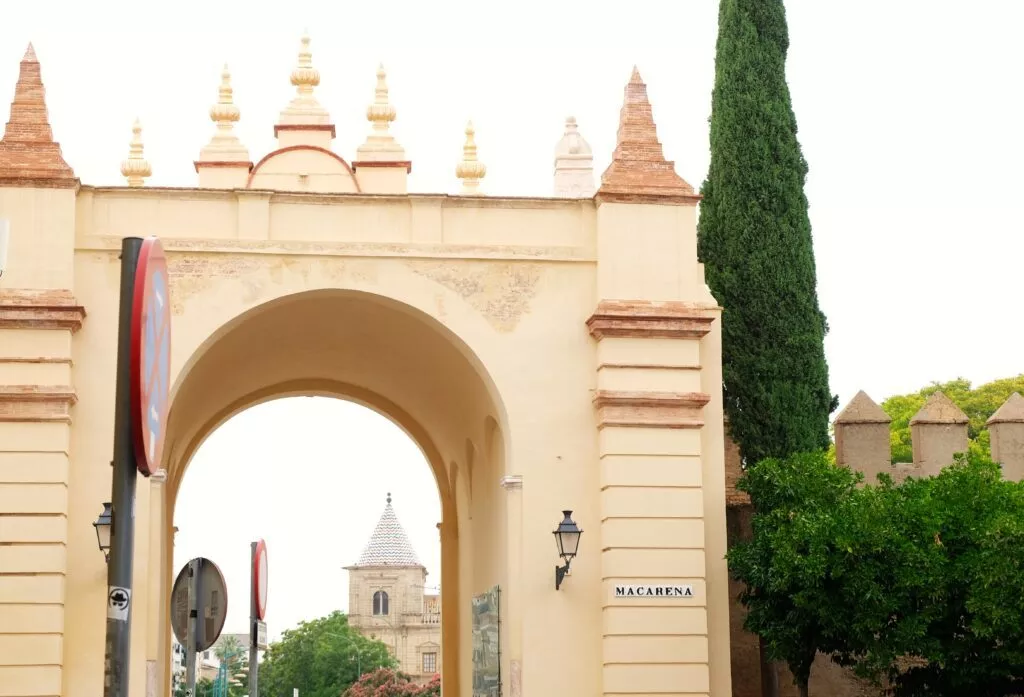
Note: from the 14th century onwards, several kings such as Alfonso XI of Castile, Isabella I of Castile, Charles I of Spain and Philip IV entered Seville through this gate.
The Alcázar of Seville an incredible wonder to visit in Seville
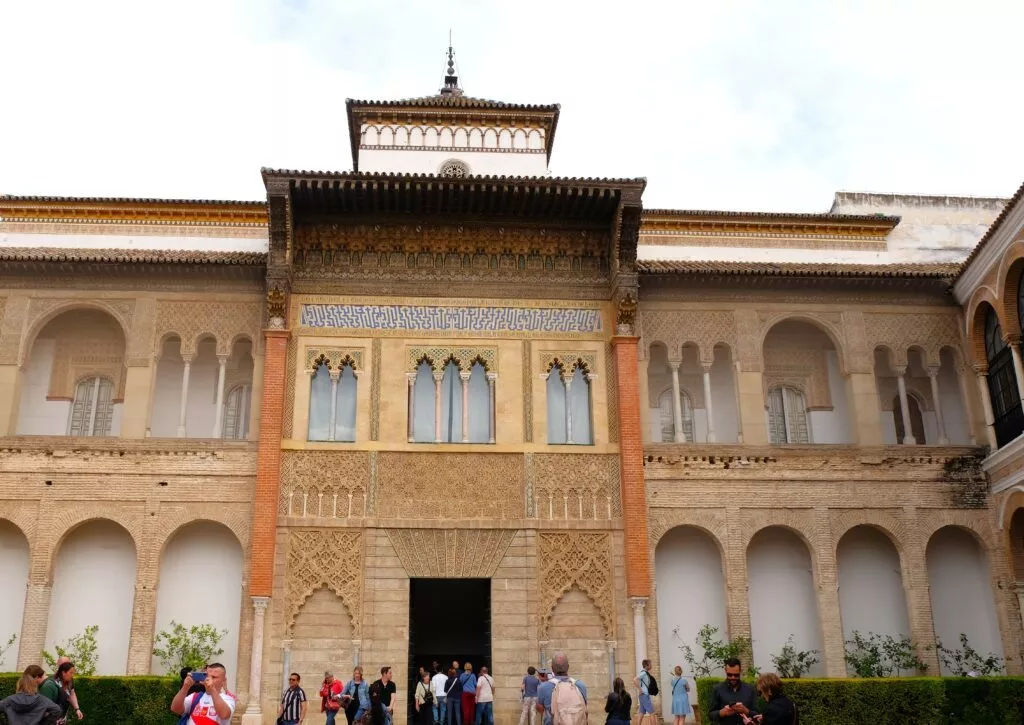
The Alcázar of Seville is a fortified palace built by the Umayyads. It is considered to be the finest example of Mudéjar architecture on the Iberian Peninsula. It is a jewel not to be missed.
The Alcazar was built from 844 during the reign of the Umayyad Amir Abd al-Rahman II, on a former Roman and Visigoth site.
The Alcazar underwent several transformations over time, both during the Al-Andalus period (under the Abbadids, the Almoravids and then the Almohads) until 1248, and in the centuries that followed.
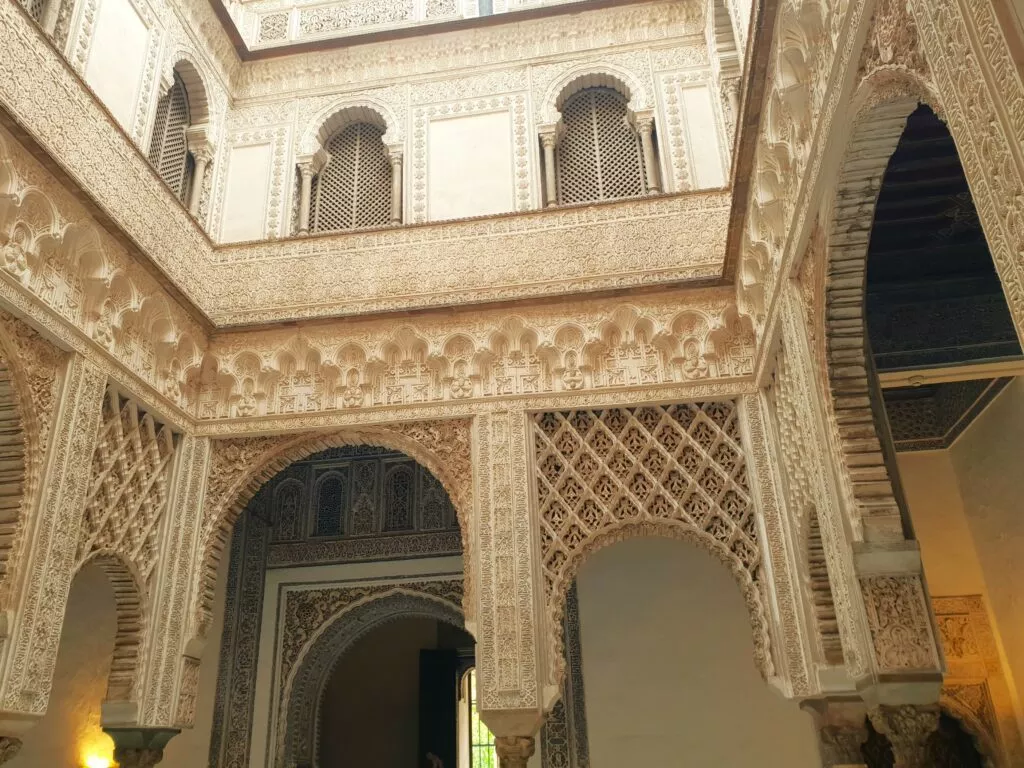
A visit to the Alcázar
The Alcázar is a vast complex made up of several palaces, gardens and courtyards, all lavishly decorated.
Here are just a few examples:
- The Patio de la Montería, the main courtyard of the Alcázar
- The Patio del Yeso is a patio decorated with mosaics and stucco, a rectangular courtyard with a pool in the centre
- The Patio de las Doncellas, a marvel like no other, surrounded by a gallery of poly-lobed arches, one of the most characteristic decorative motifs of the Almohad dynasty, along with the decoration of sebka canvases.
- The Salón de Embajadores, the main hall of the palace, used as a throne room by King Pedro I :
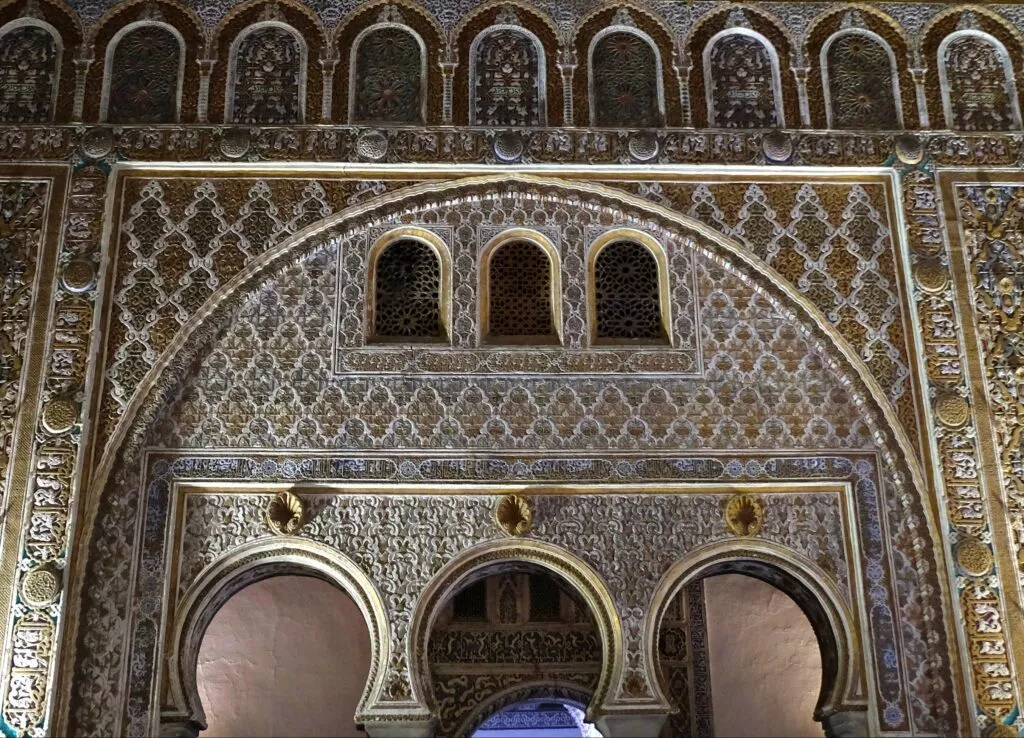
The room is square, in the image of the Muslim “qubba”, in which the square symbolises the earth and the dome the universe.
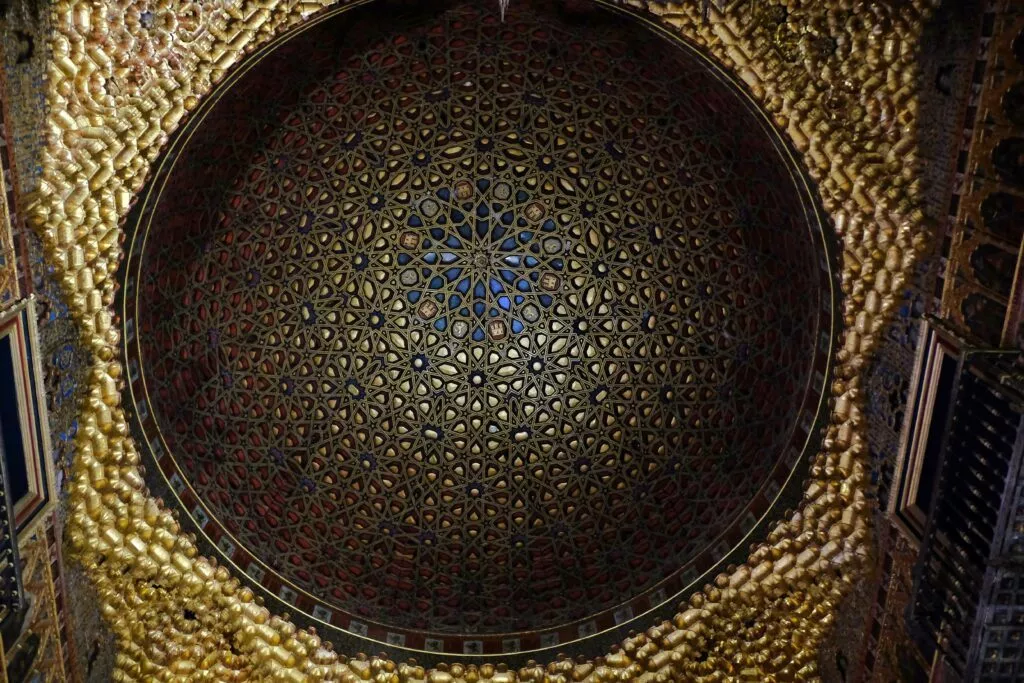
Note: After the Reconquista, the Alcázar was used by the Catholic kings and their successors. In fact, it is still the official residence of the Spanish royal family when they visit Seville. This makes it one of the oldest royal palaces in use anywhere in the world!
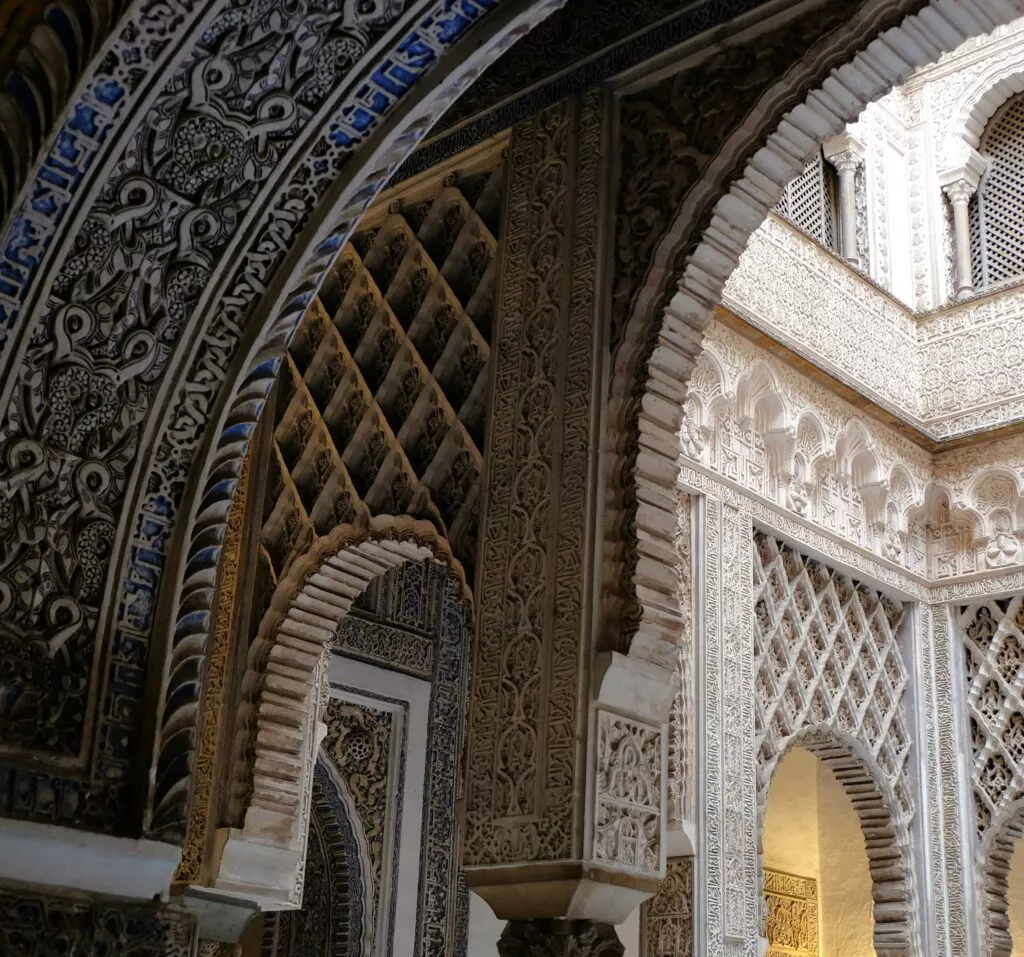
The gardens of the Alcazar
Finally, don’t forget to visit the Alcazar gardens, which have been cultivated for over 1,000 years! Today they are a series of lush gardens with fountains, pools and fruit trees.
In conclusion, Seville’s Alcázar, a UNESCO World Heritage Site and one of Spain’s most popular monuments, is a must-see for visitors to Seville.
Note: the palace was used as a filming location for the famous TV series ‘Game of Thrones’, earning it worldwide fame.
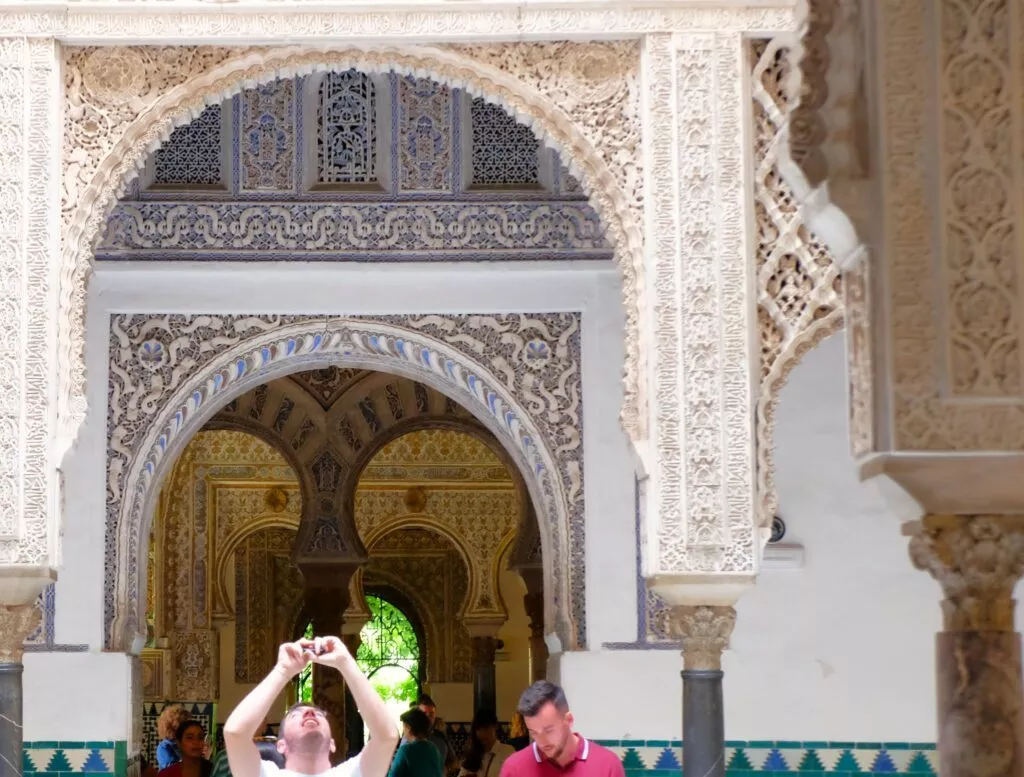
Book online your ticket to visit the Alcázar.
One last suggestion not to be missed on your walking tour of Seville: the Palacio de Las Dueñas.
No photos of this Las Dueñas Palace….. go there with your eyes closed. You’ll be amazed!
You can buy a ticket online to visit this private palace.
If you are in the western part of the Costa del Sol and would like to visit Seville, you can use the following link to book a day trip from Torremolinos, Mijas or Benalmadena.
Where to have a drink and some tapas in the center?
The center of Seville is a permanent invitation to stroll through its charming streets and immerse yourself in the local culture.
Take the opportunity to taste traditional Andalusian cuisine and tapas. Here are two addresses that will not disappoint you:
La Casa Morales
This is one of the oldest bars in the Andalusian capital. It is a real institution for Sevillians.
This is the Hijos de E. Morales bar, but which is more commonly called Casa Morales or Bodega Morales.
Indeed, this bar opened in 1850, and it is still run by the same family. With its old wine jars in the second room, we find ourselves in the essence of the Sevillian atmosphere.
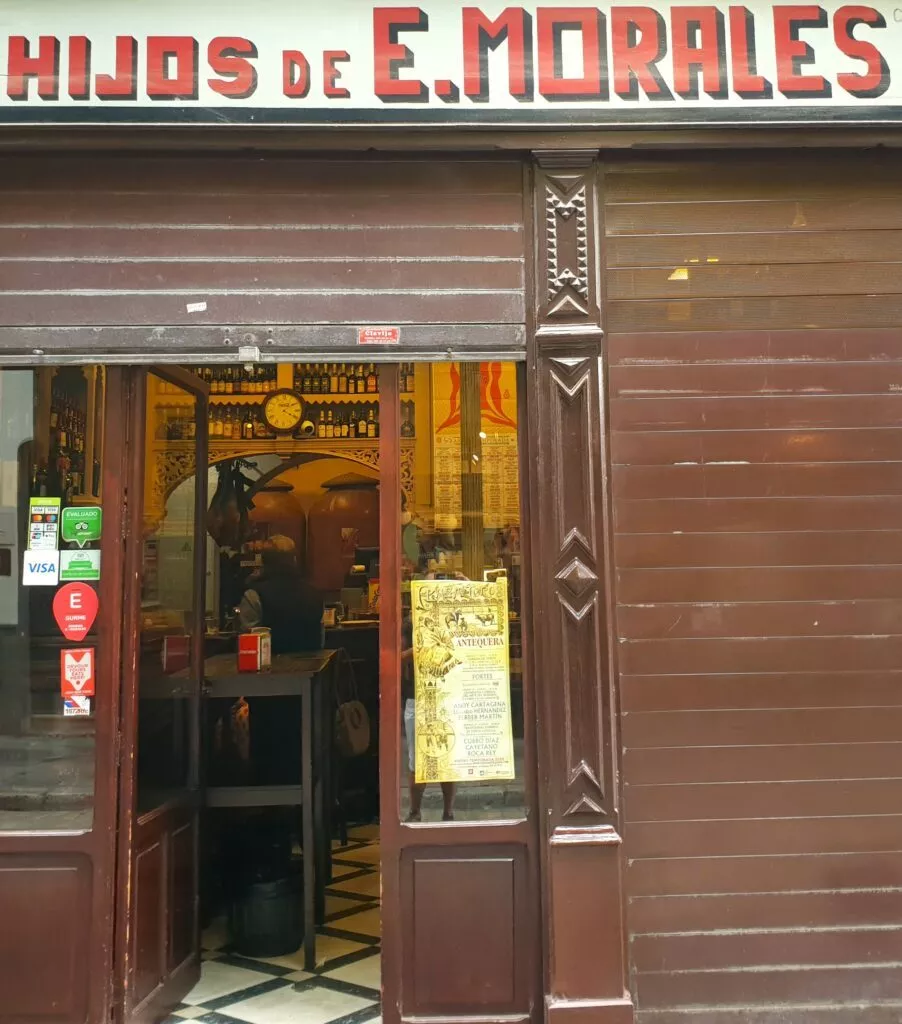
Originally this bar was only a store selling Valdepeñas wines. Over time he offered other wines and then tapas.
It is also one of the best places to taste the local specialty, orange wine, with some tapas, based on Iberico, cheese or fish. On the montaditos side the choice is also vast.
This bar is always very busy and its wines and tapas are excellent.
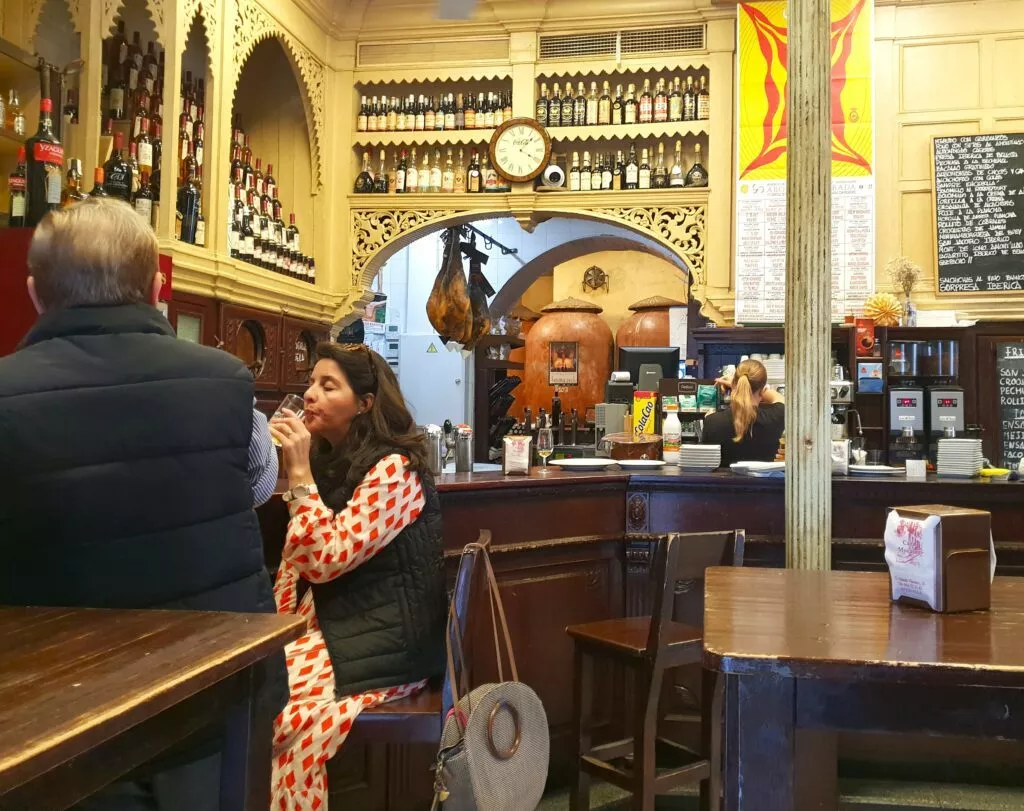
Here you will find the location of Bar Hijos de Morales.
Bar Alfala
This bar, as its name suggests, is located in the beautiful Alfalfa district, right in the center of Seville. I think you will find the best atmosphere for this bar in the early evening.
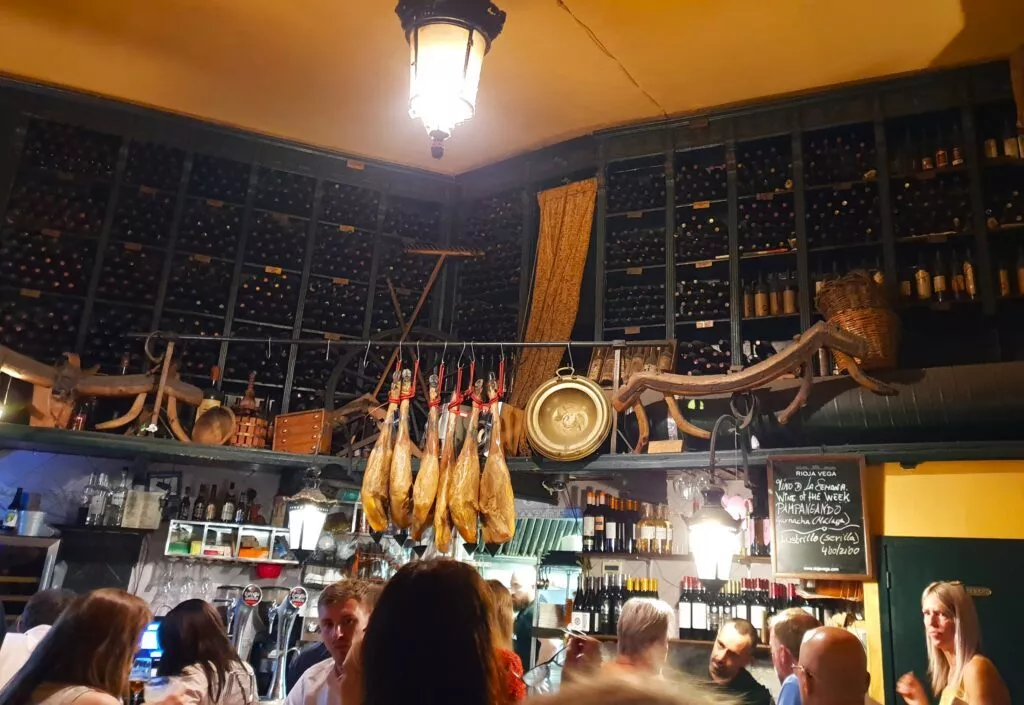
In this bar you will appreciate the very authentic Sevillian atmosphere and sometimes even a pinch of typically Andalusian humor like about beer…see below 🙂
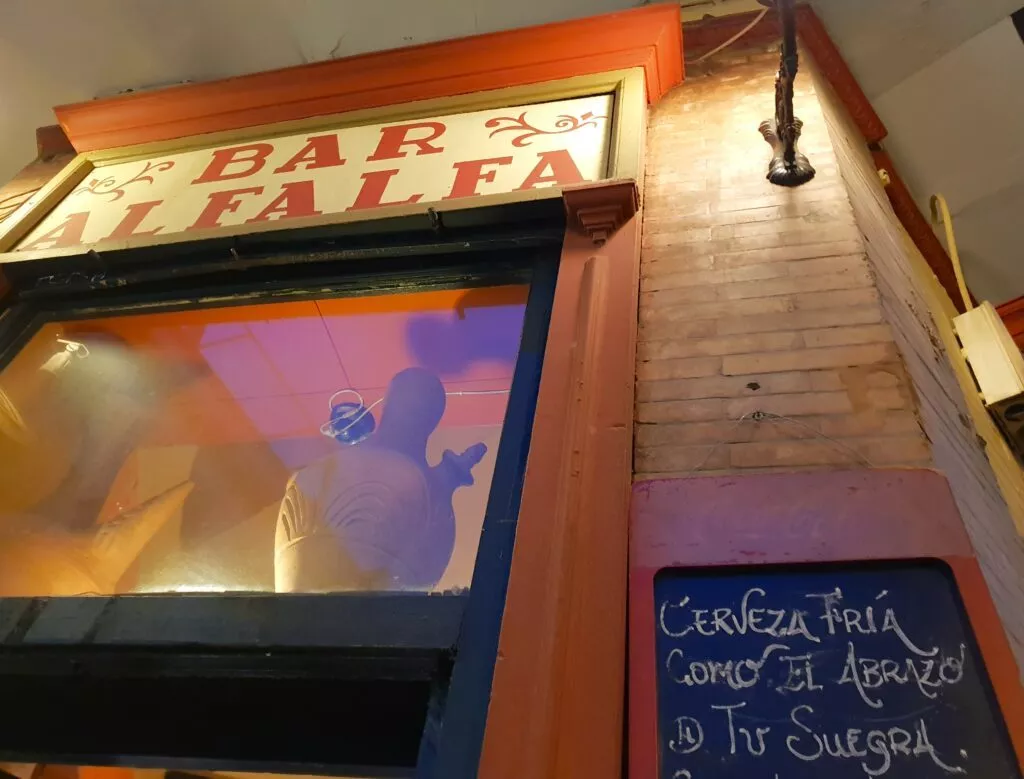
Here you will find the location of Bar Alfala.
Visit Seville at night
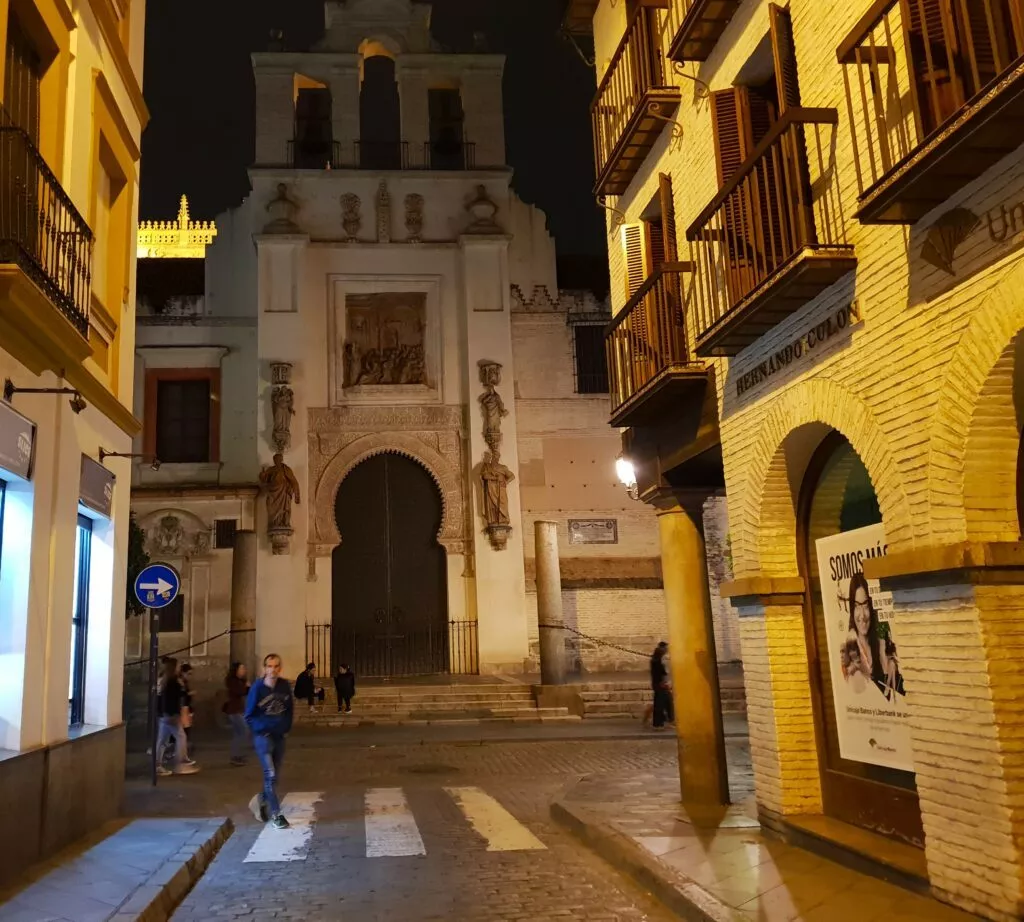
Seville offers the possibility of beautiful evening digestive walks, along the Guadalquivir as well as in the center.
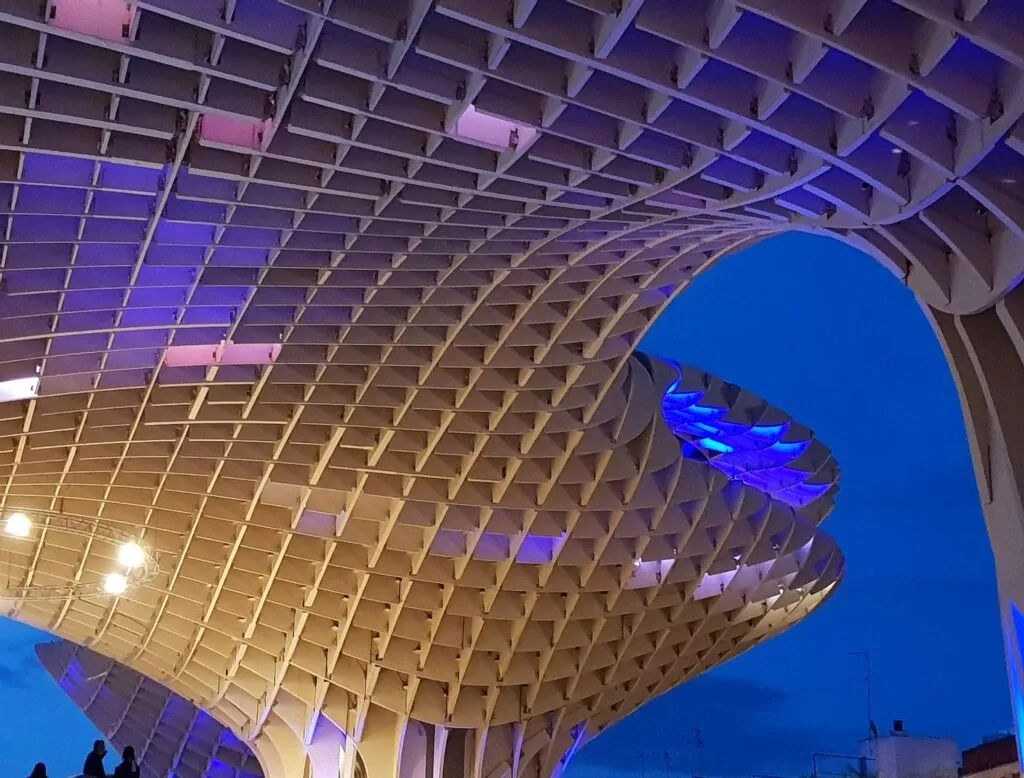
It’s a real pleasure to leave at night to explore the illuminated monuments. And the other advantage is that the temperature in the evening is always pleasant 🙂
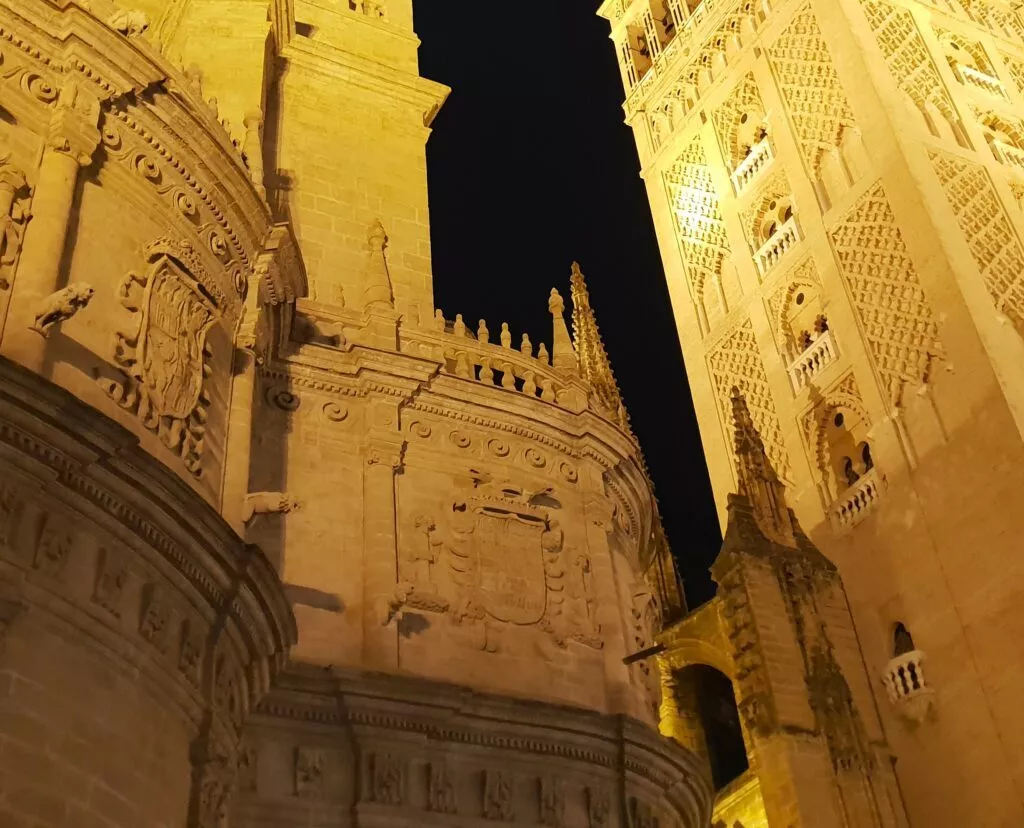
With its rich and varied history and its multitude of spectacular sites, Seville is an ideal city for an evening stroll.
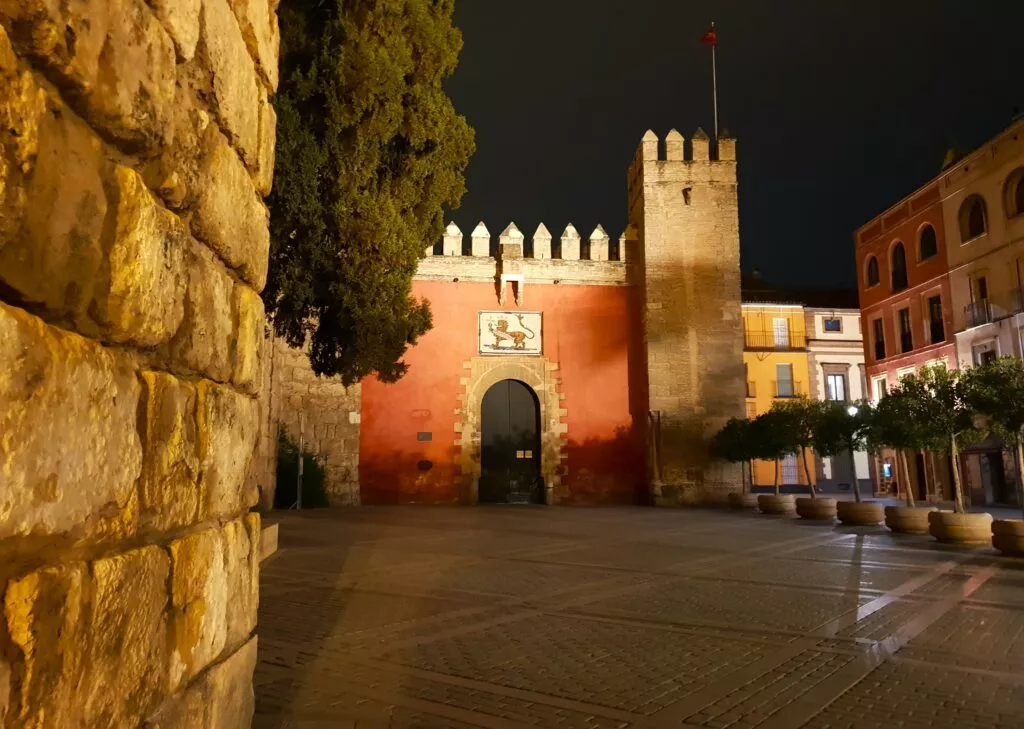
On a completely different note, it is also possible to take a cruise on the Guadalquivir, the only navigable river in Spain.
Finally, don’t leave Seville without attending a flamenco show. Seville is one of the best places to have this experience. Many tablaos offer evening shows, where you can let yourself be carried away by the passion and energy of flamenco dance and music.
Here are 2 beautiful addresses with an excellent reputation:
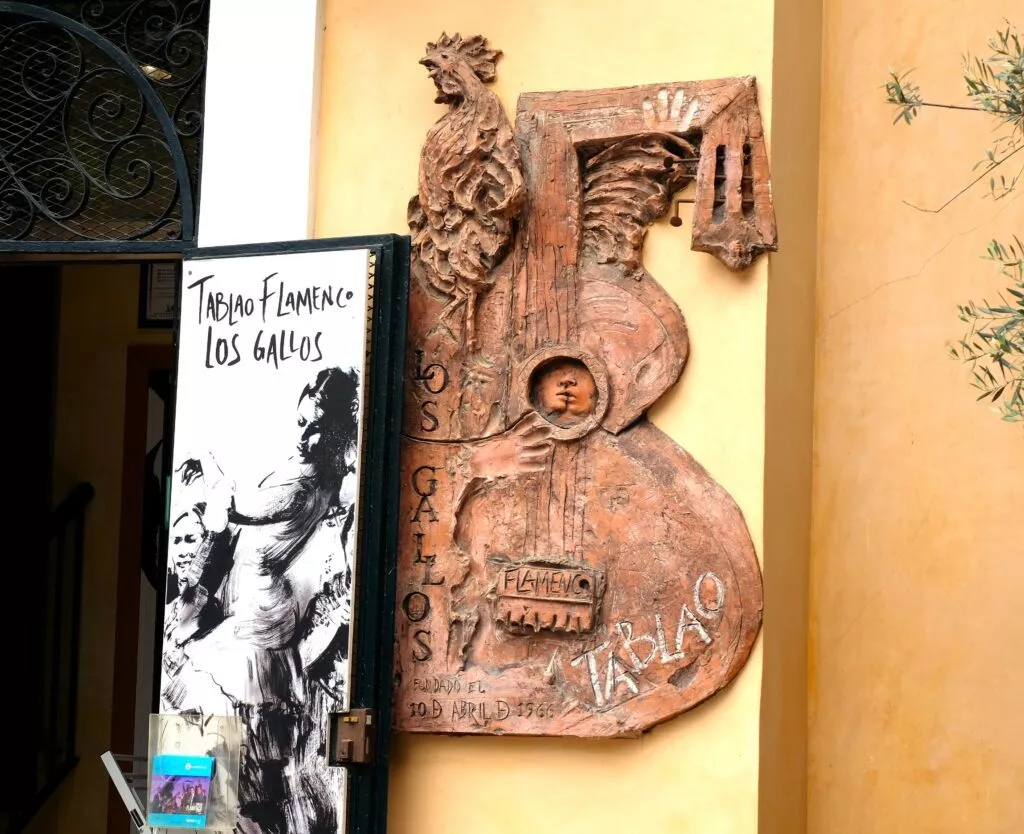
Find in the center, in Santa Cruz district: Tablao Los gallos
in the Triana district: Teatro Flamenco Triana.
In conclusion, a few days walking tour of the center of Seville is a true immersion in Spanish culture.
From impressive monuments to picturesque neighborhoods, gastronomy and flamenco shows, this city has everything to please travelers looking for authenticity.
So, pack your bags and set off to explore magnificent Seville!
English-speaking guide for private tours of the centre of Seville and surrounding areas
For those who wish, there is a great English-speaking guide, Victor, who offers several ways of private tour of Seville.
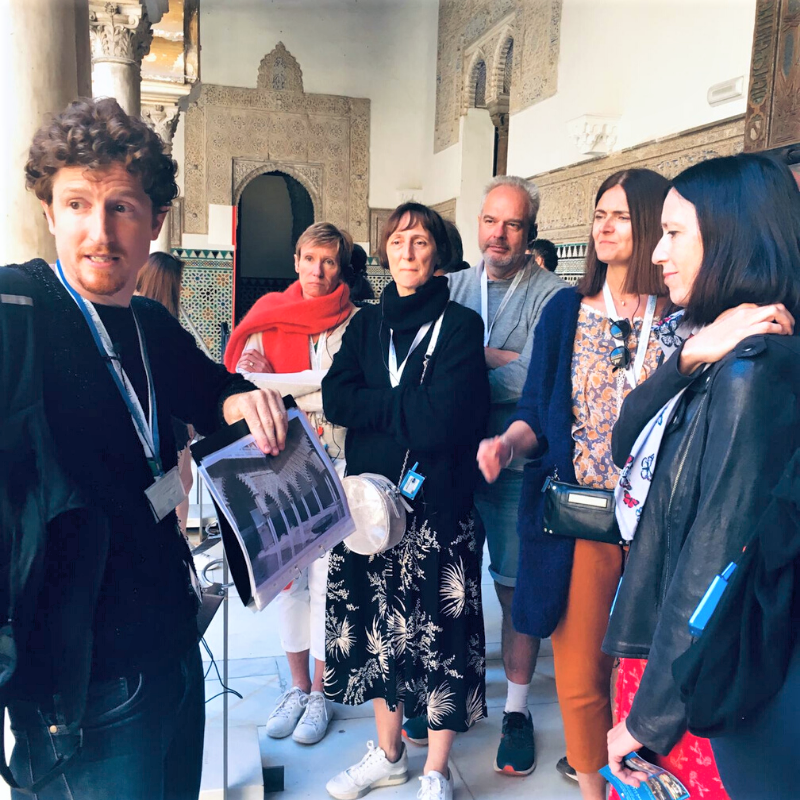
Book accommodation in Seville
To book accommodation in Seville at the best price, it’s advisable to book well in advance.
Note: if you’re coming during the Seville Fair, it’s advisable to book even further in advance.
Book activities in Seville
In the link below you’ll find all the activities you can enjoy in and around Seville.
An idea to relax in Seville after a good walk 🙂
At number 15 on Aire Street you will find a palace-house that is… five centuries old!
In the very center of Seville, a few steps from the cathedral, you will cross a small patio before starting a real journey of sensations. You will find yourself, in the light of dozens of candles, among different bathrooms at different temperatures, spread throughout the house-palace.
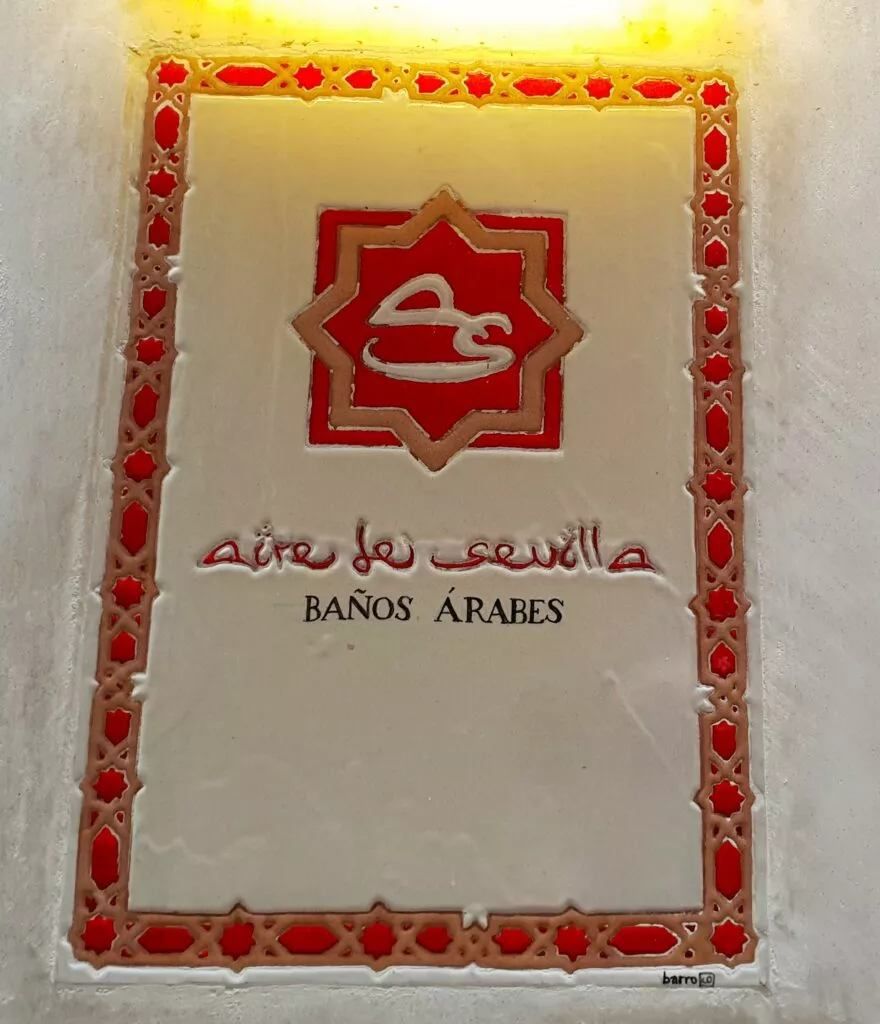
These Arab baths are themselves located on Roman ruins from the 1st century AD. Some of them can be seen in the current flotarium.
Here is another great address for those who want a good massage: there is Espacio Infinito, still in the center of Seville.
To find out more and/or book: Espacio Infinito.
Some useful links (car hire, ideas for visits)
Easy and economical bookings
What to see in Seville after the historic center walking tour
Seville, the Andalusian capital, is a city of incredible wealth and is worth several days of visiting, which you can continue through different neighborhoods around the center.
Here are several ideas to continue your visit to Seville:
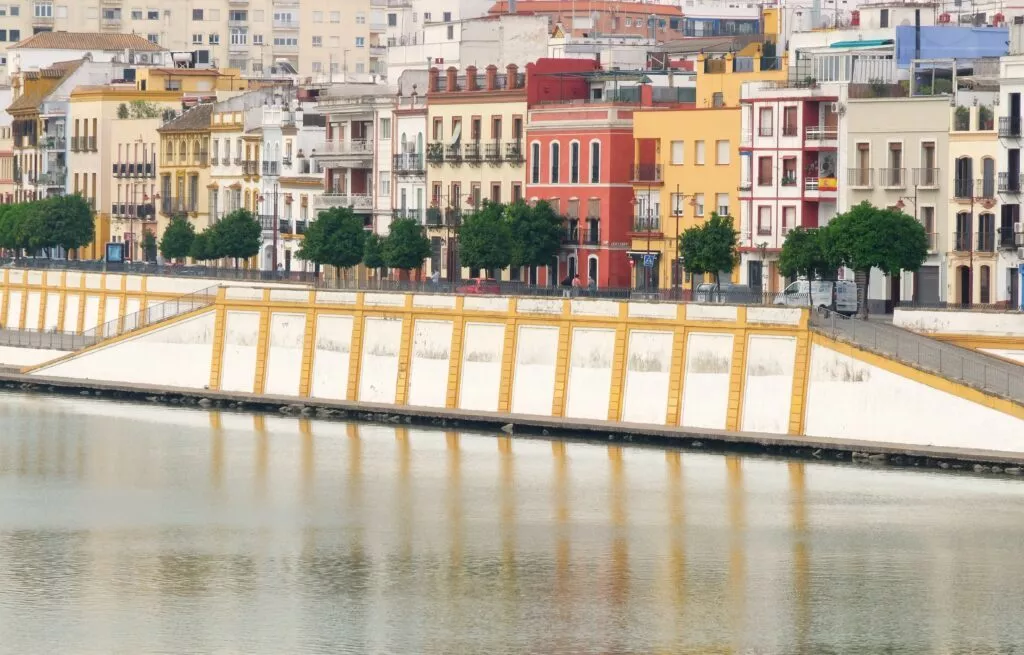
- Visit the Triana district:
- the wonderful covered market of Triana
- Betis street
- Santa Ana Church
- the emblematic Isabelle II bridge
- the Carmel chapel
- the callejón de la Inquisición
- Plaza del Altozano
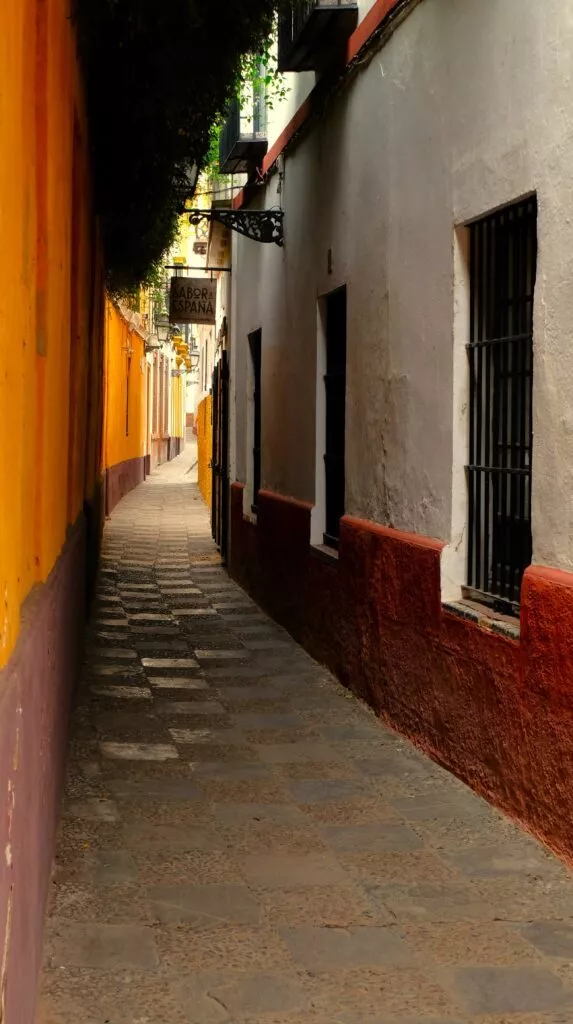
- Join the fabulous Santa Cruz district to discover some of the city’s wonders, including :
- the old judería
- Callejón del Agua
- Church of Santa María la Blanca
- Explore the unusual and secret Seville, and have a drink on the terrace of the highest rooftop in Andalusia to enjoy the sunset over Seville
Note: for those interested, here’s a page with 8 great leisure activities to enjoy in Seville.
Continue your trip to Andalucia
Cadiz
Here is a link for a visit, which combines sea and beautiful city, for all those who are staying a few days in the surrounding area: what to see in Cadiz. This is the opportunity to discover the oldest city in Europe, steeped in history and lined with beautiful sandy beaches.
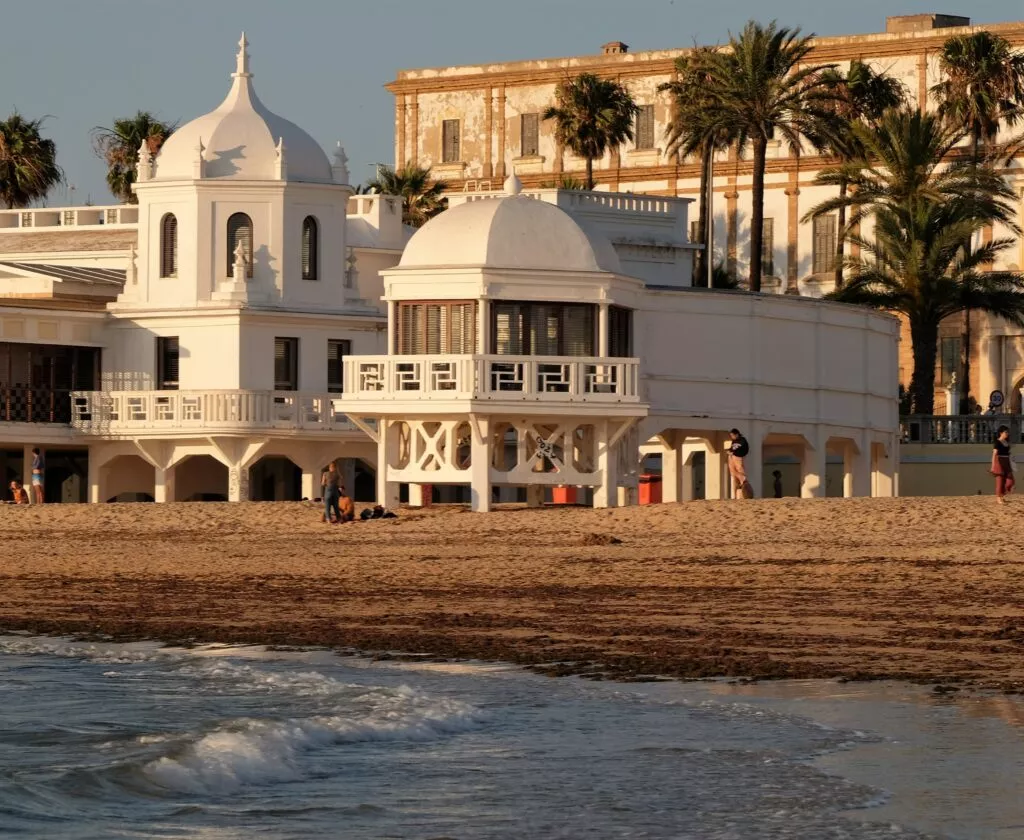
Malaga
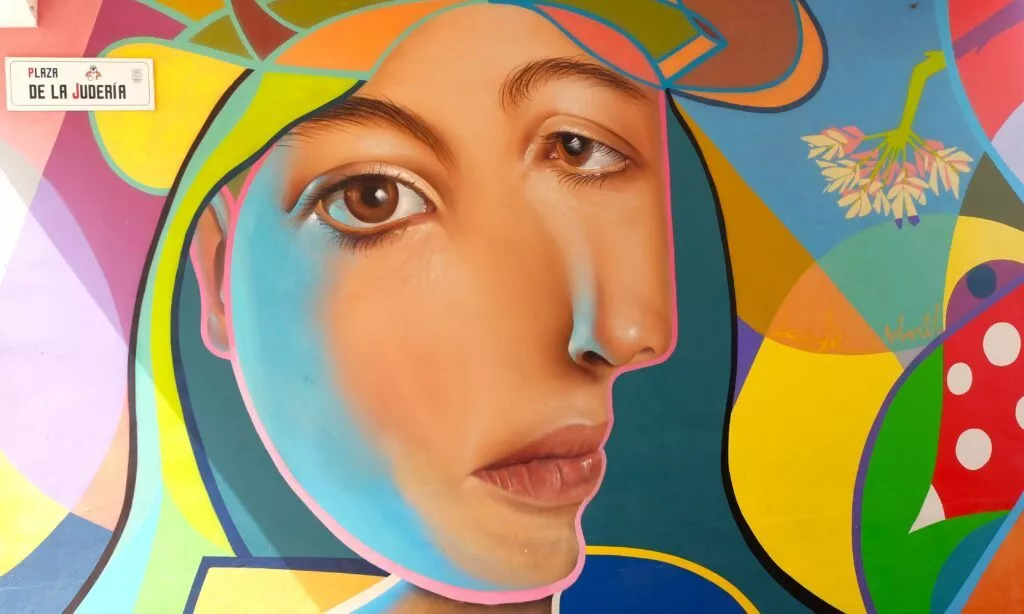
In this link, the the must-sees in Malaga.
Cordoba
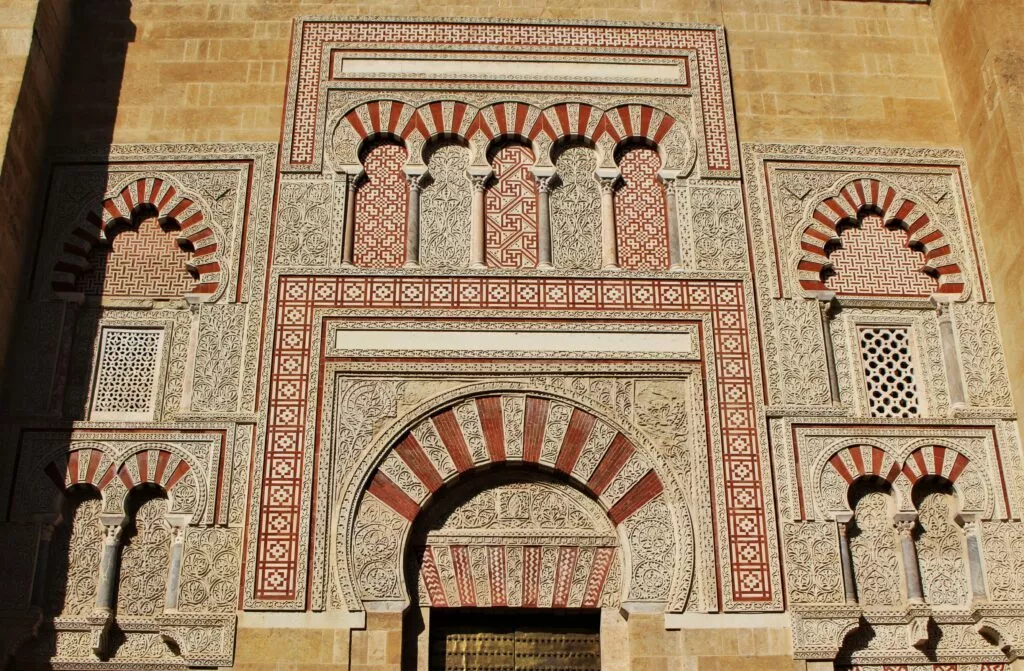
In this link, the must-sees in Cordoba.
Discover more of Andalusia’s beautiful sites in the Andalusia blog pages.
Here is the link to receive our blog newsletter.
Here are the latest articles on Andalucia
-
Interactive map of Andalucia with best places to see
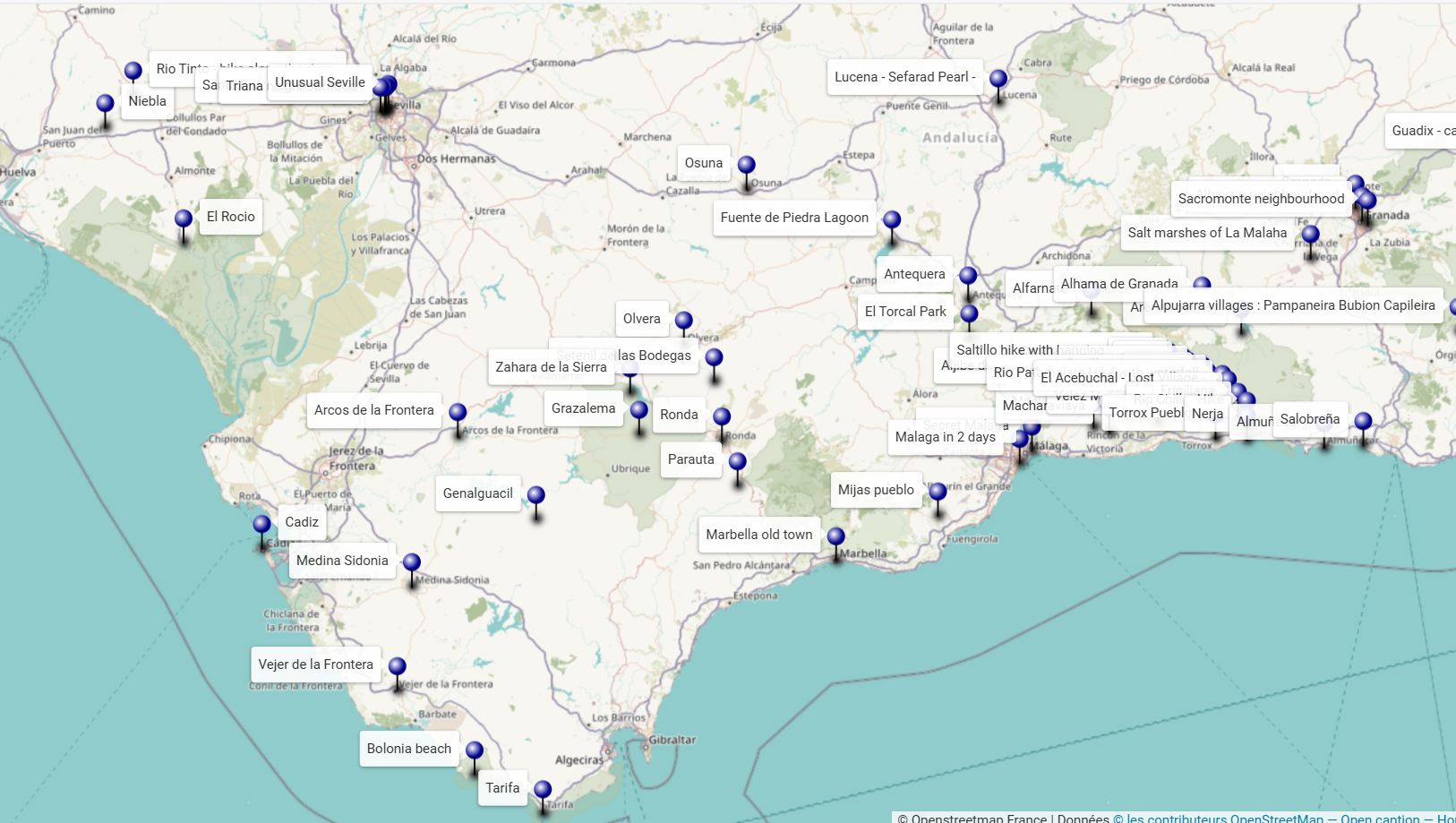
An interactive map of Andalucia to discover the sites to see around your holiday destination or to prepare a tour or road-trip.
-
Visit Olula del Rio, the Mujer de Almanzora and the museum
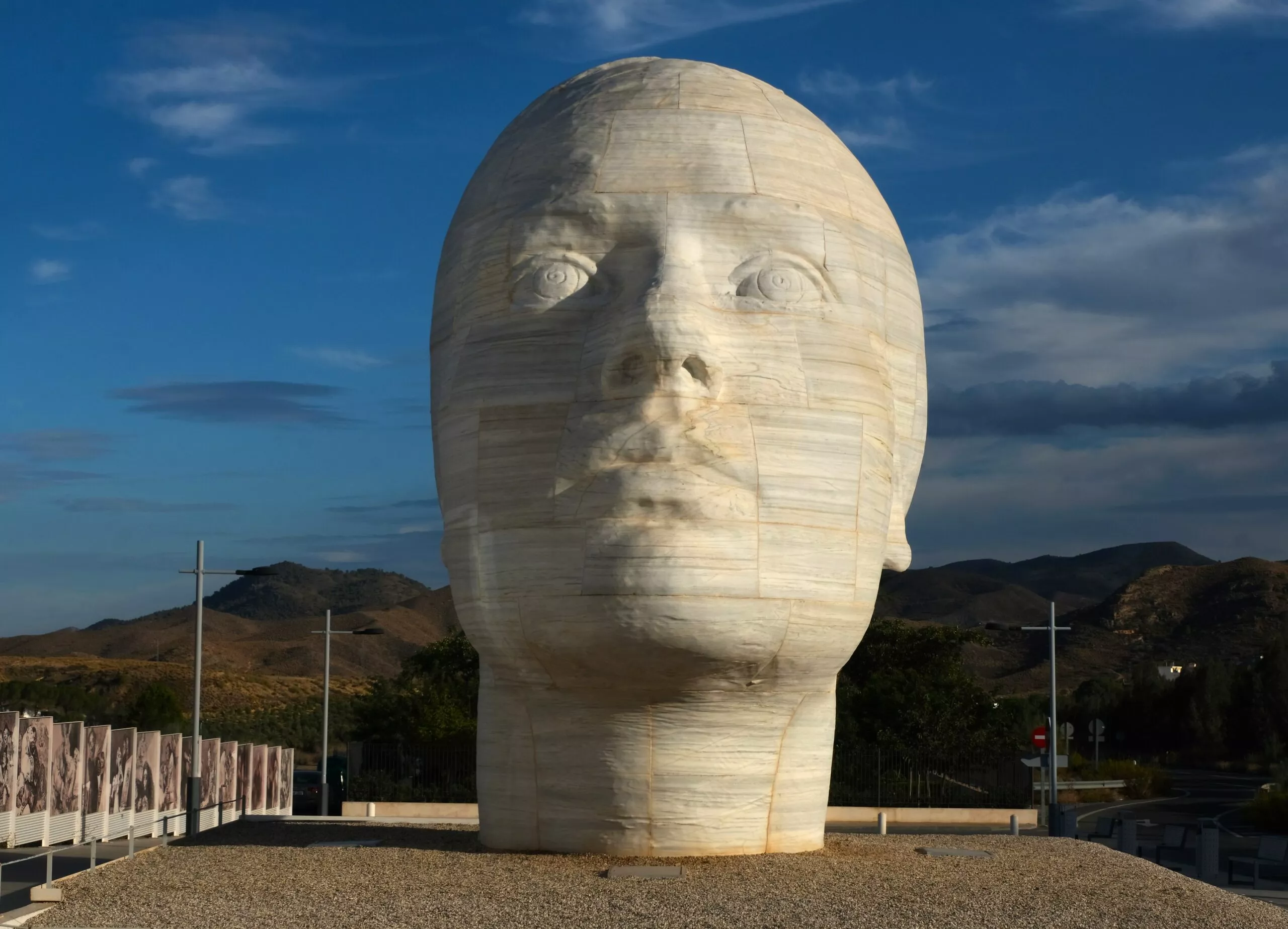
Olula del Rio see its 3 wonders: an extraordinary marble sculpture, a surprising museum and an incredible photography centre.
-
Fiesta del Queso in Zuheros Cordoba
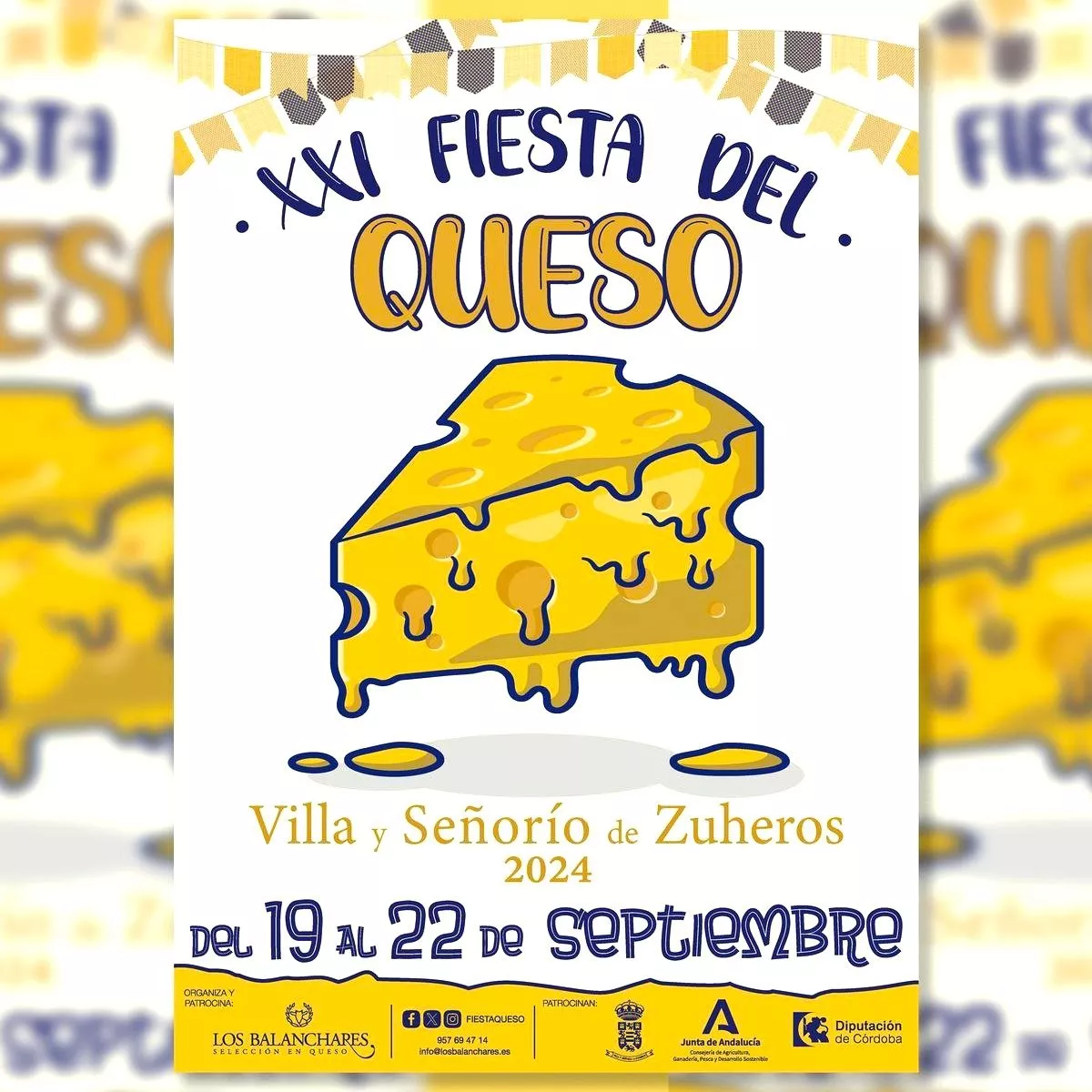
Discover the incredible Cheese Festival – Fiesta del Queso in Zuheros, one of the most beautiful white villages in Spain.
-
What to see in Baeza? – The 10 places to visit –
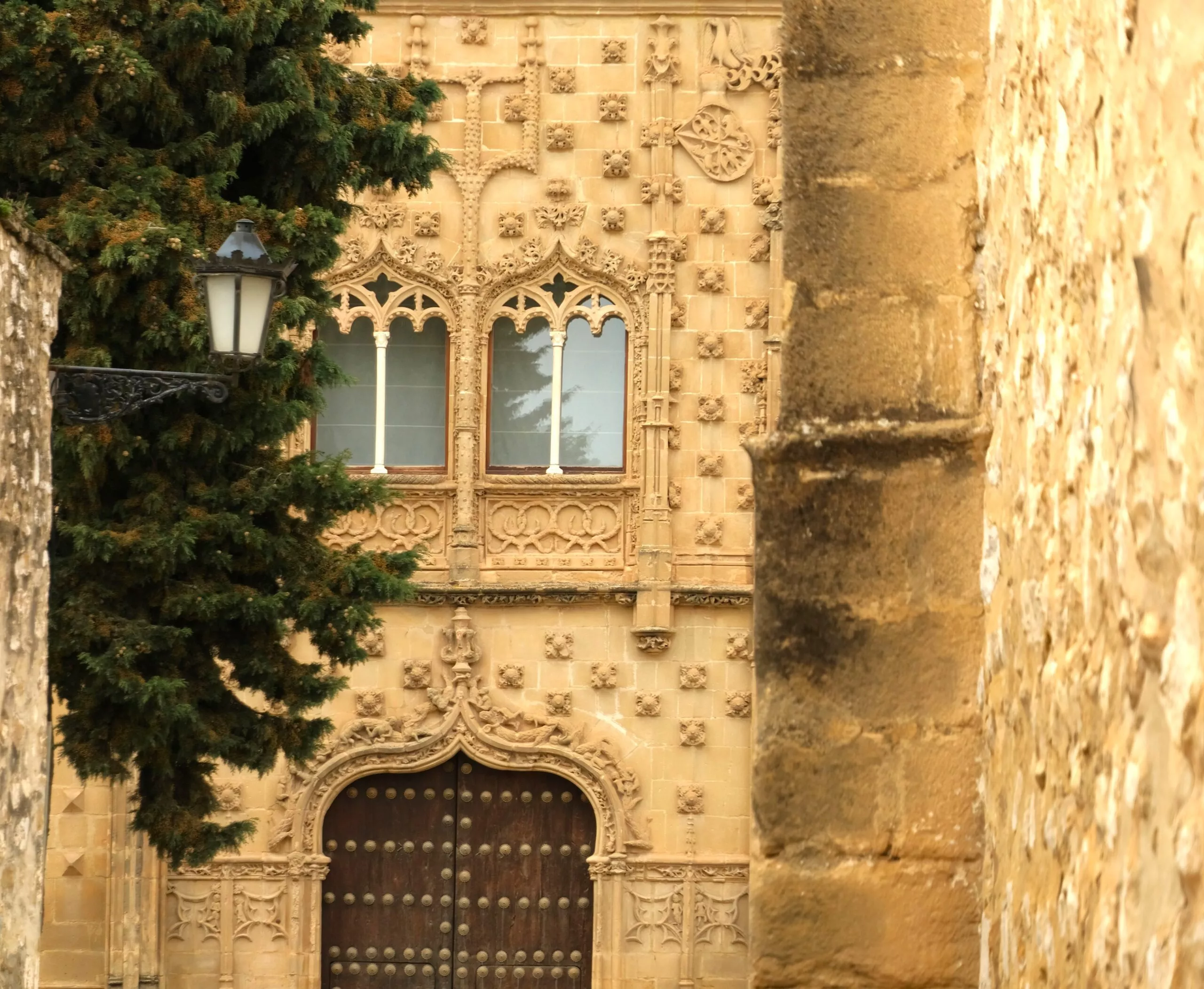
What to see in Baeza one of Andalucia’s must-see towns. Discover the best to see in Baeza, a UNESCO World Heritage Site.
